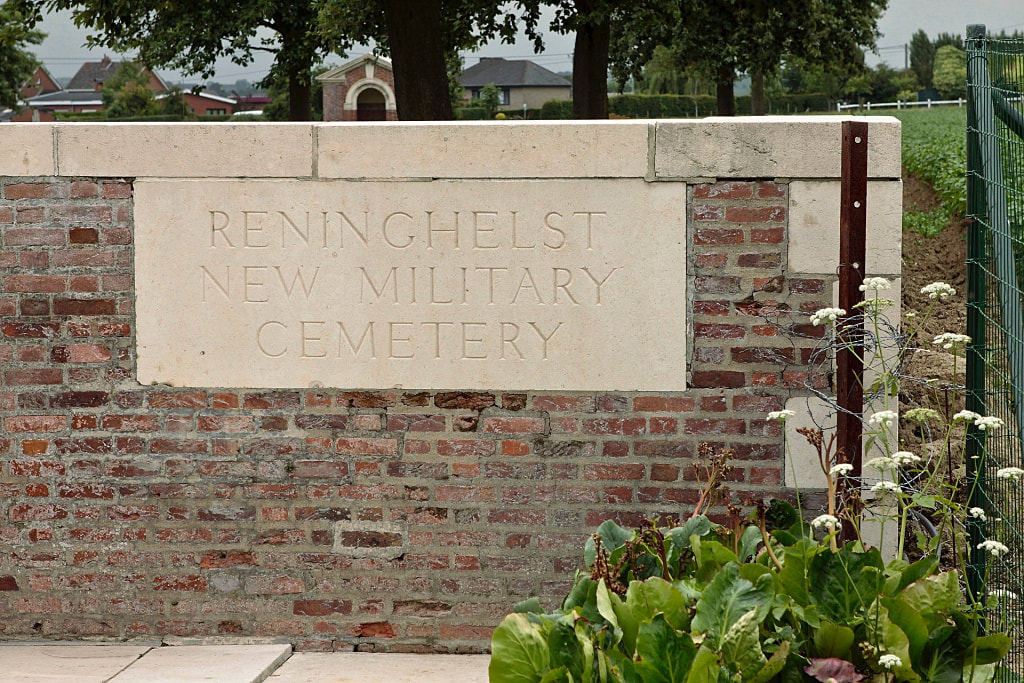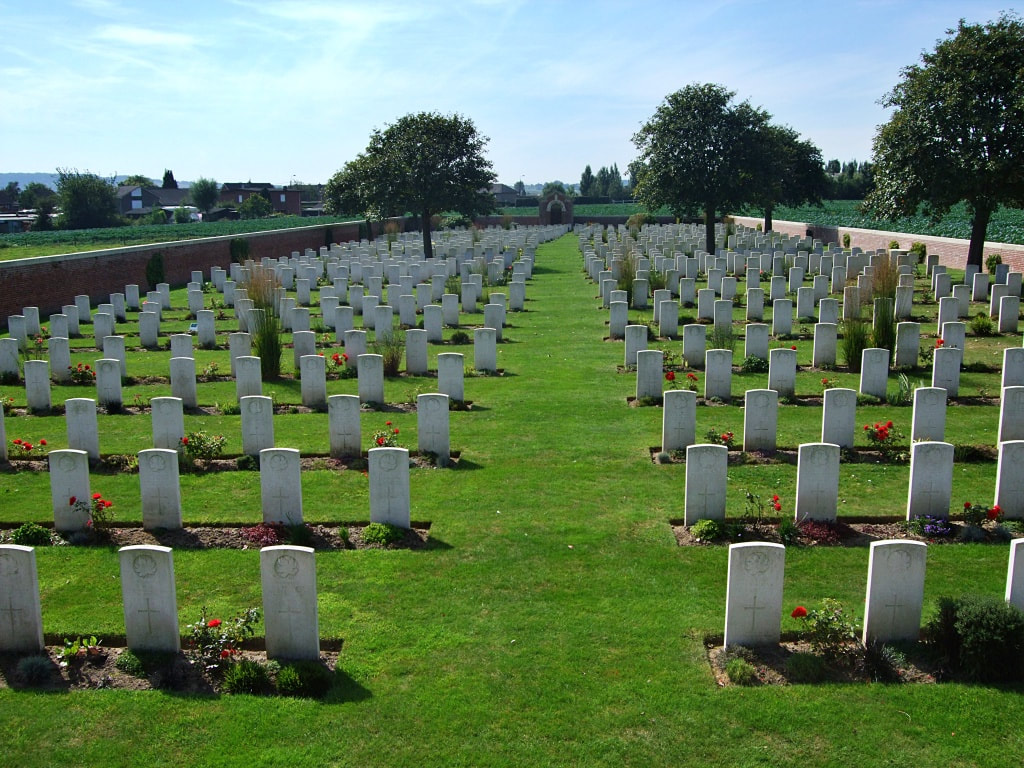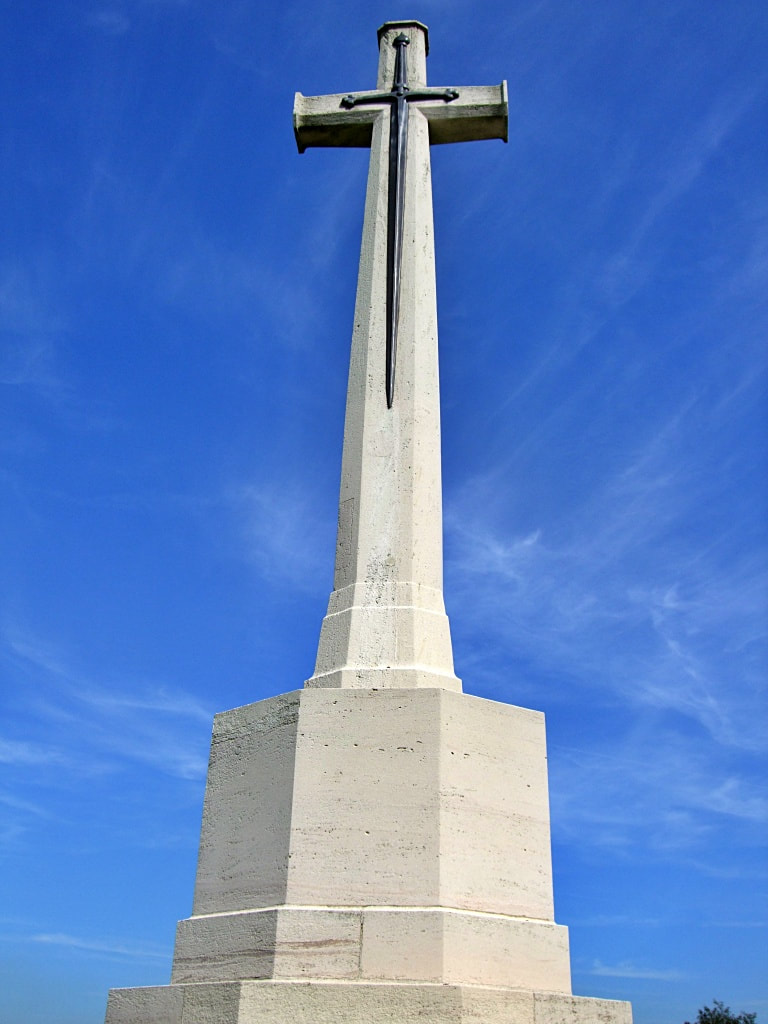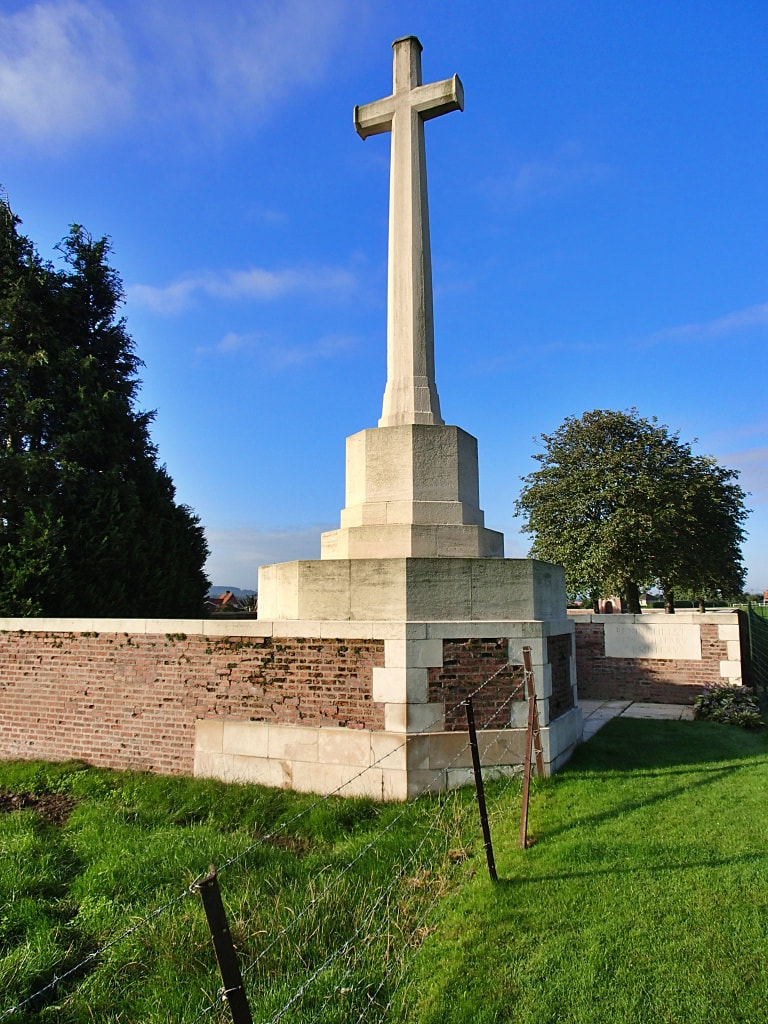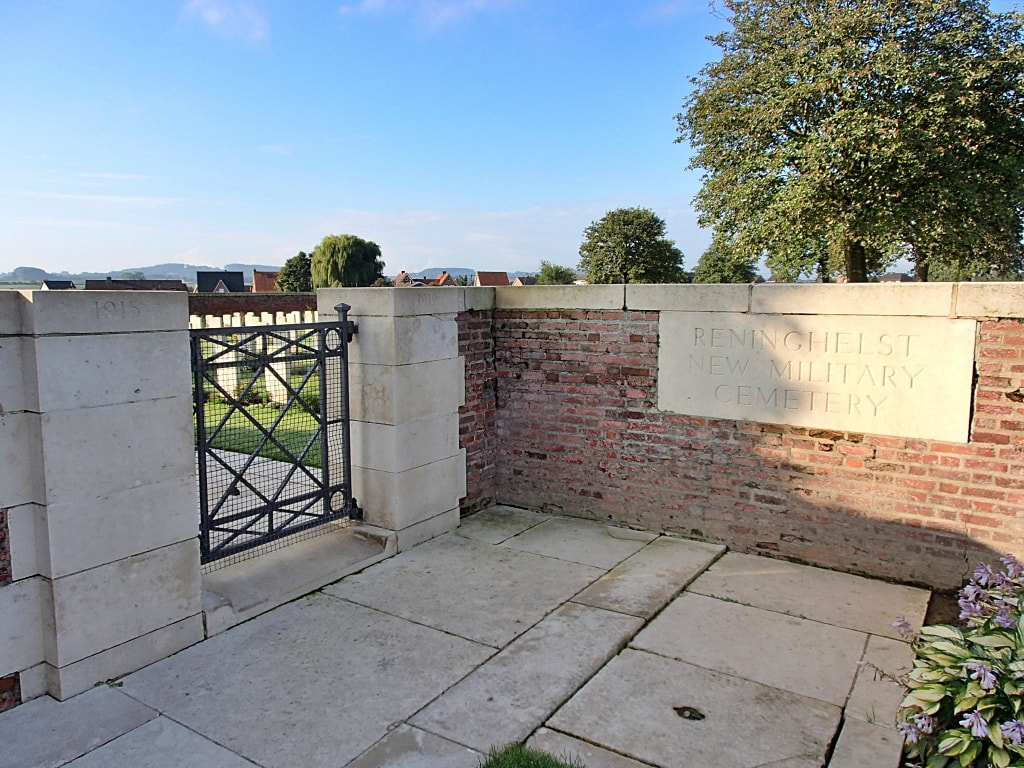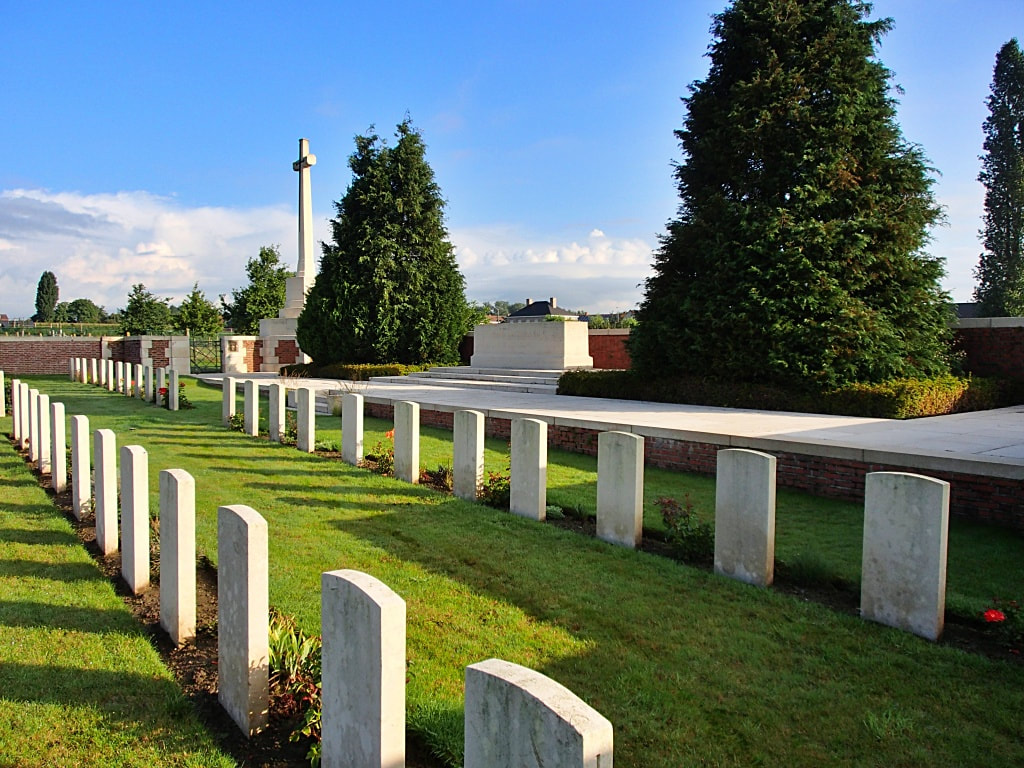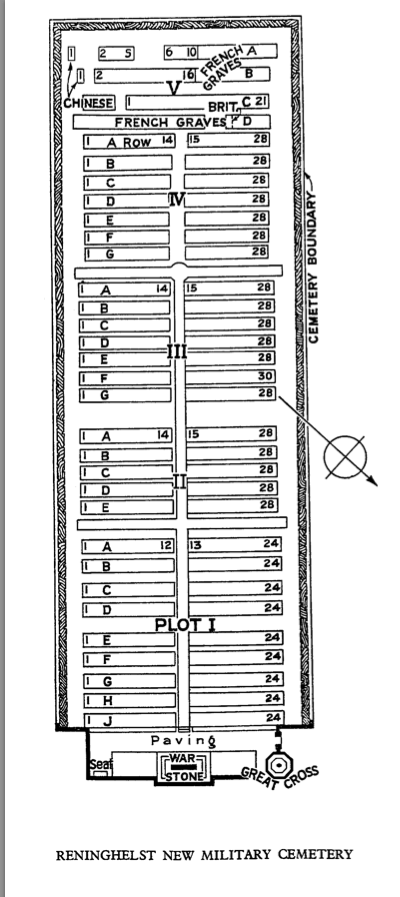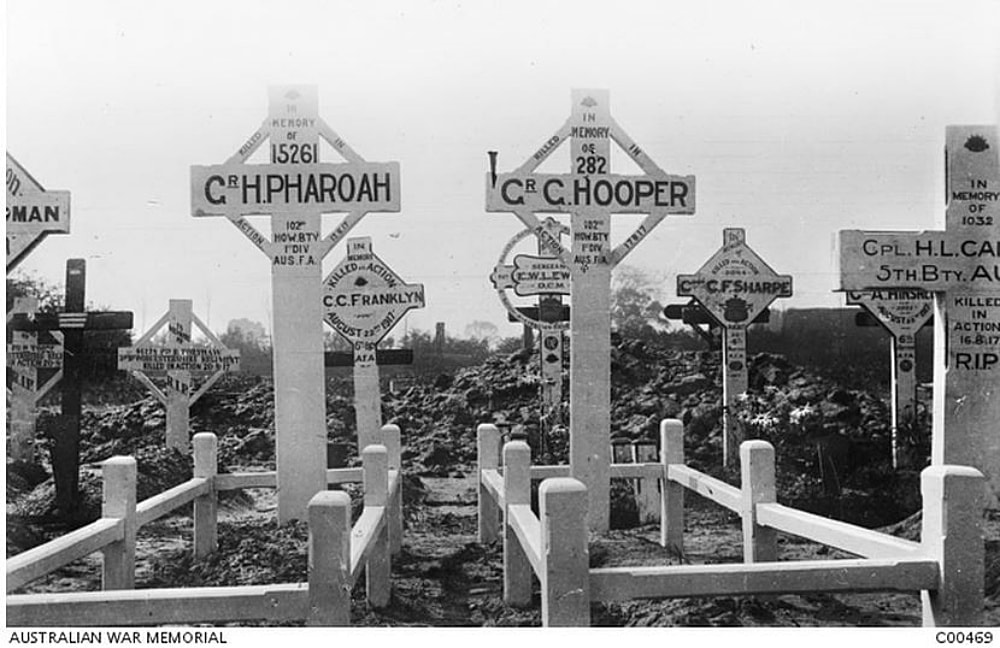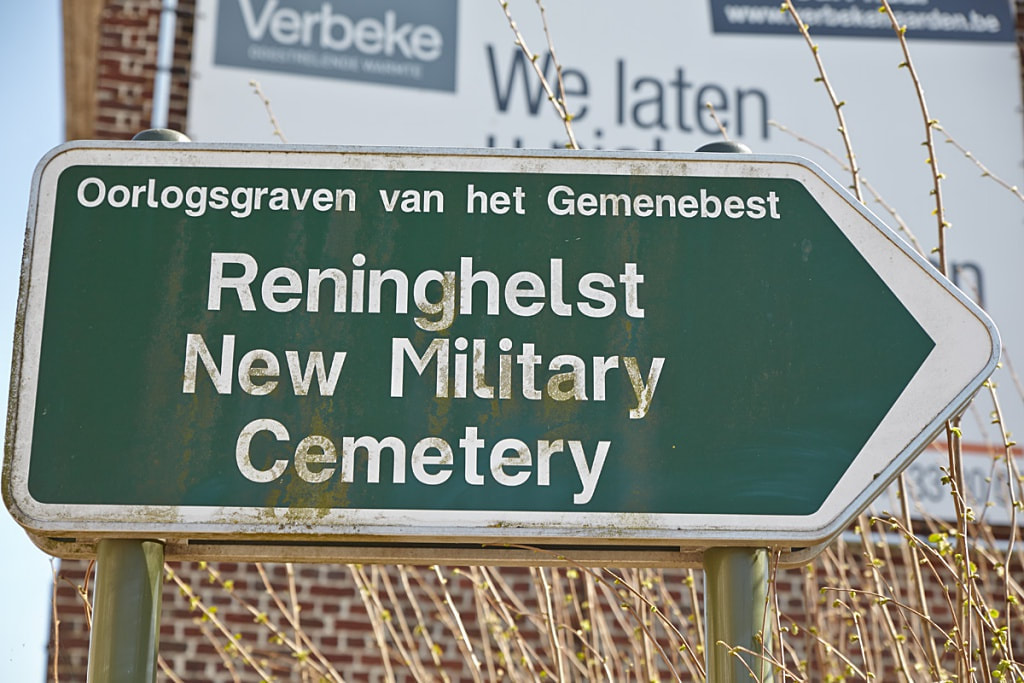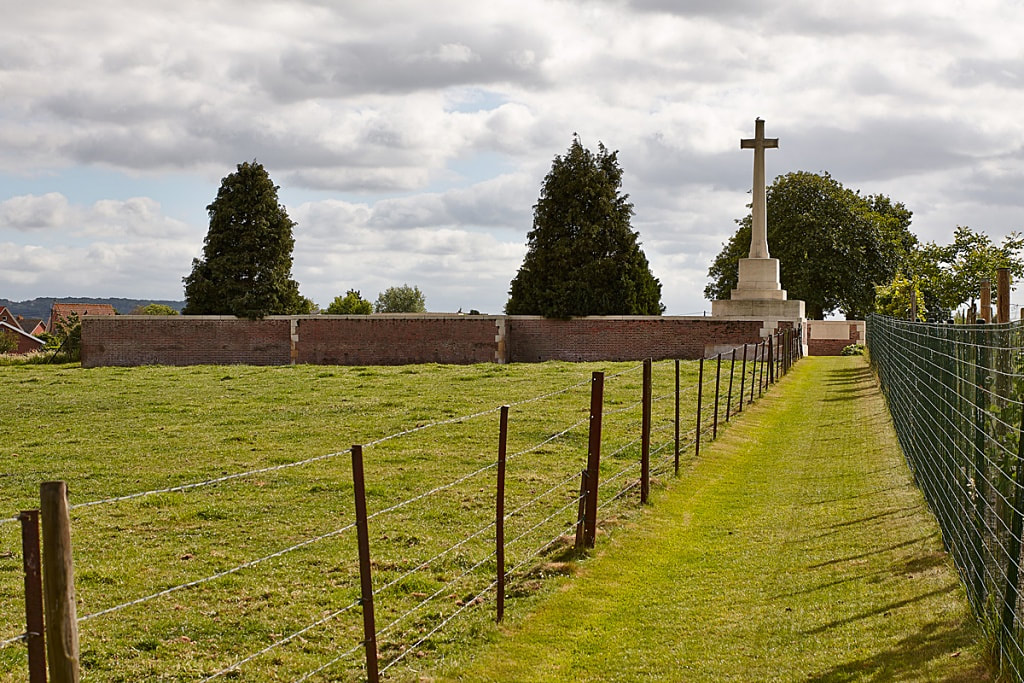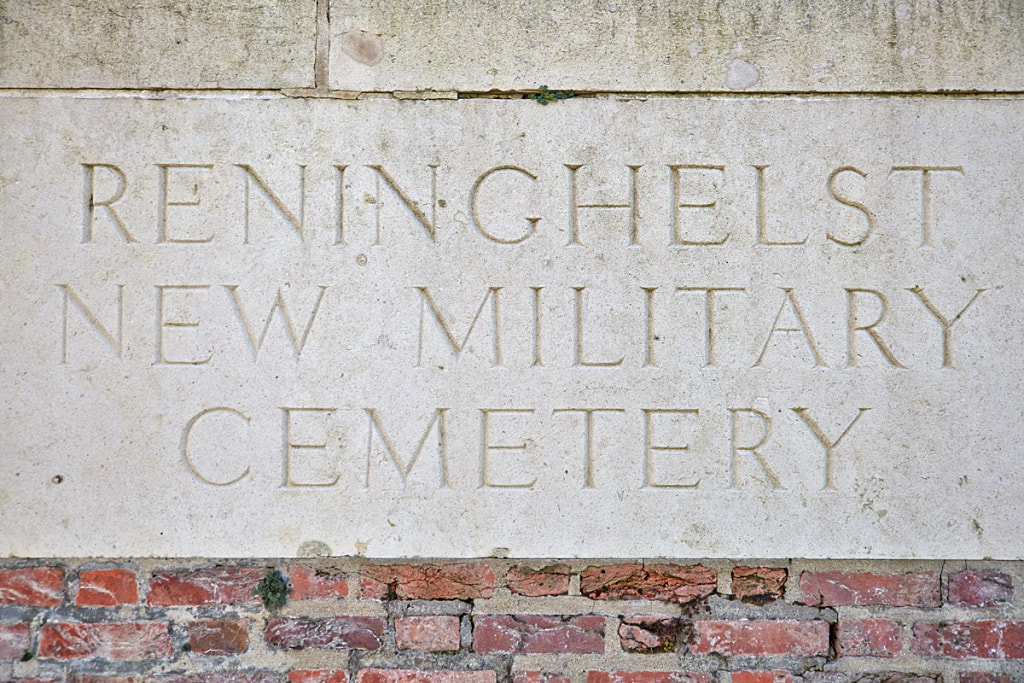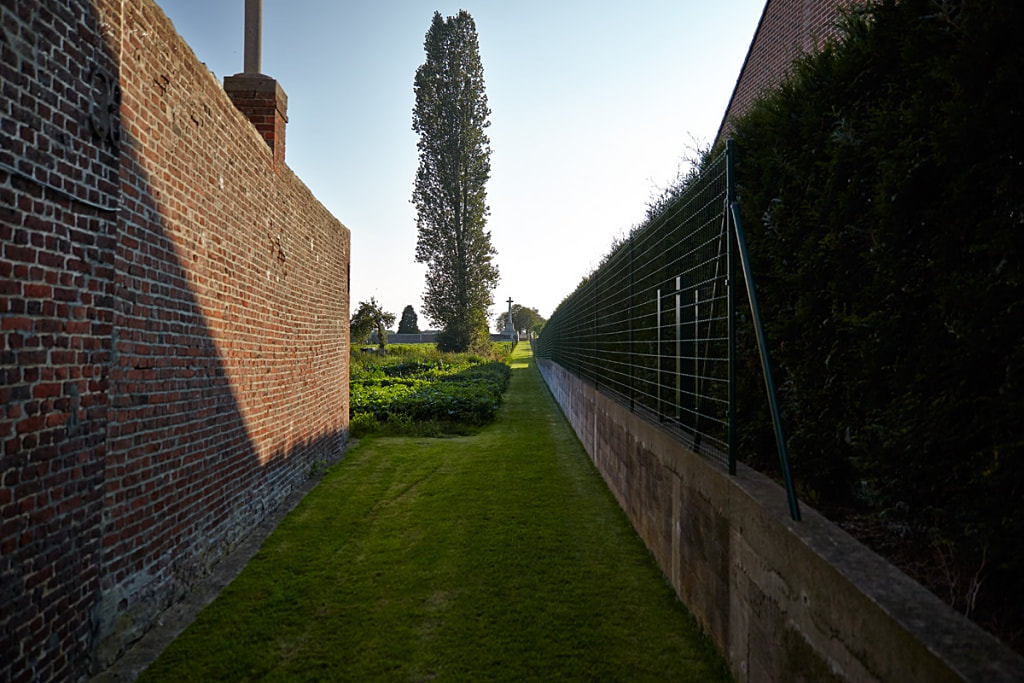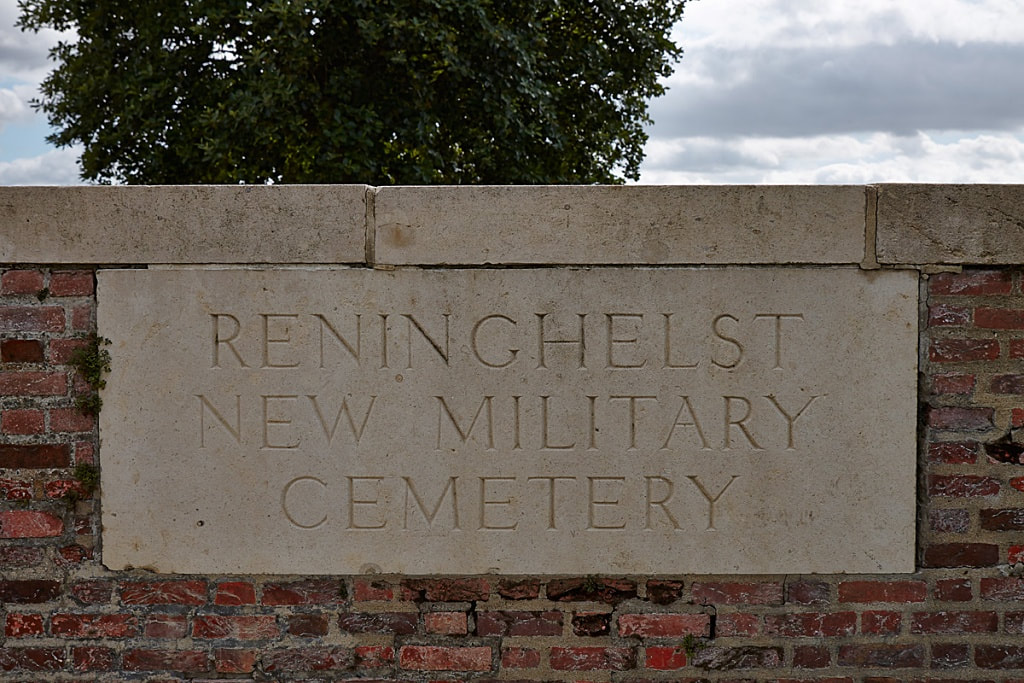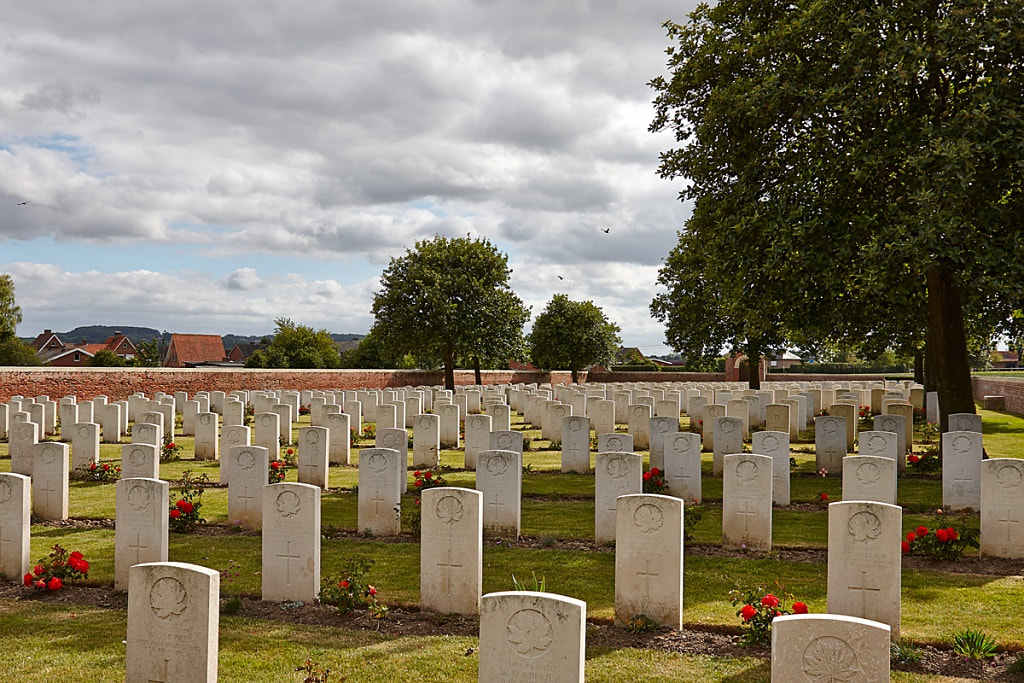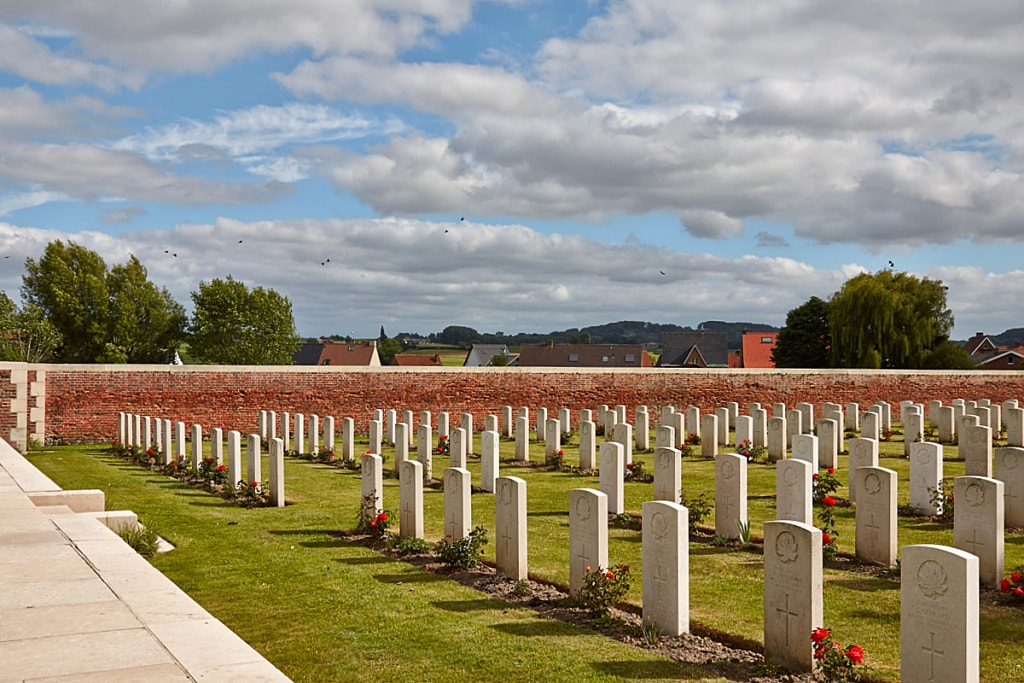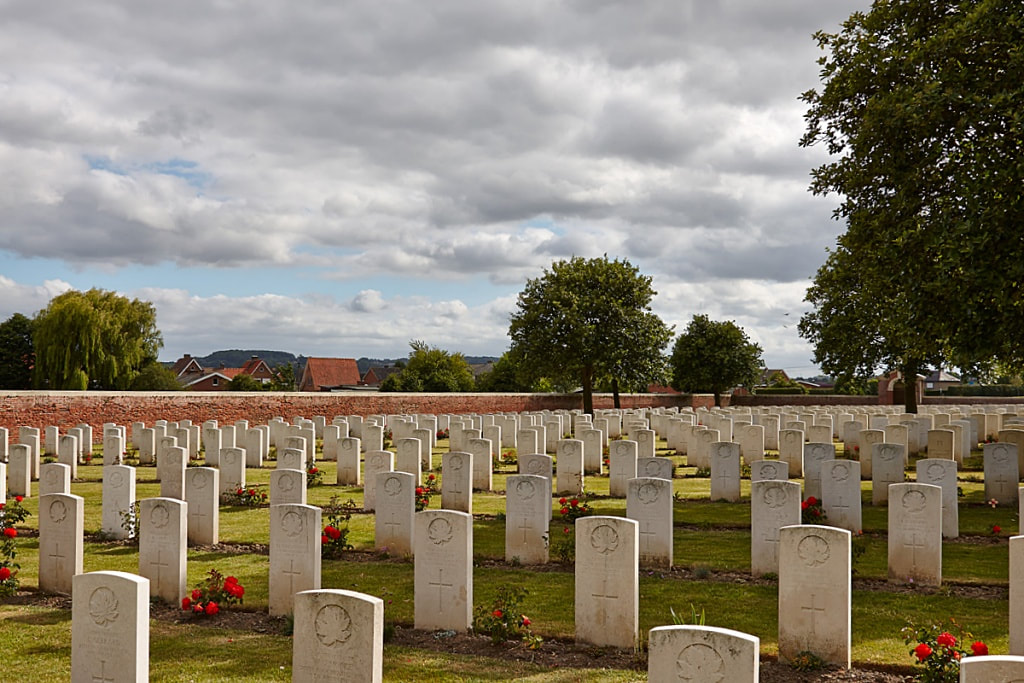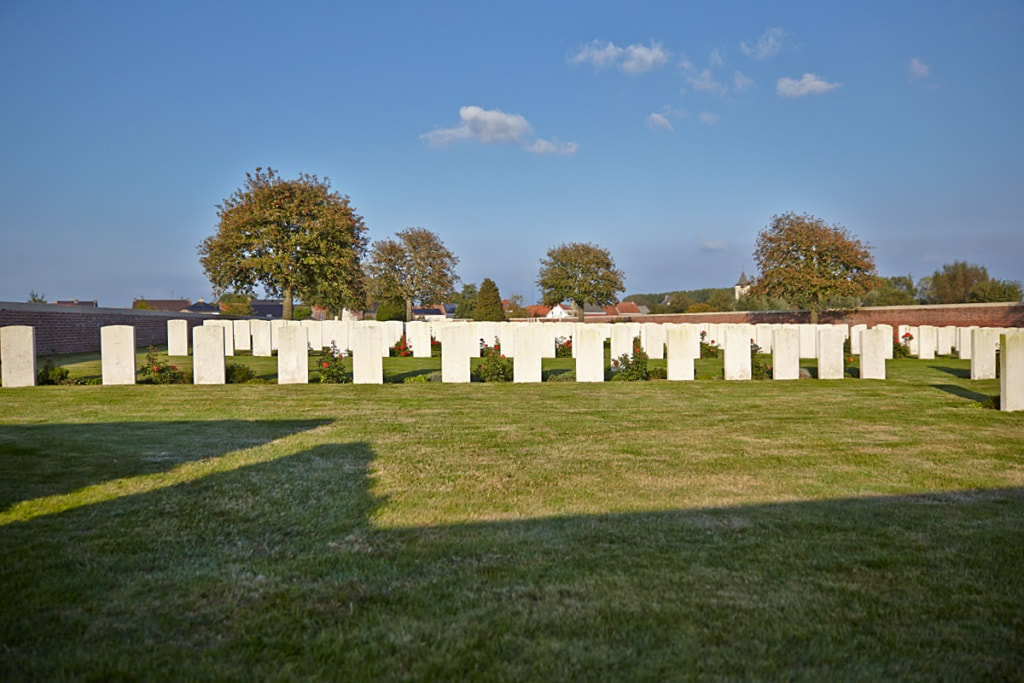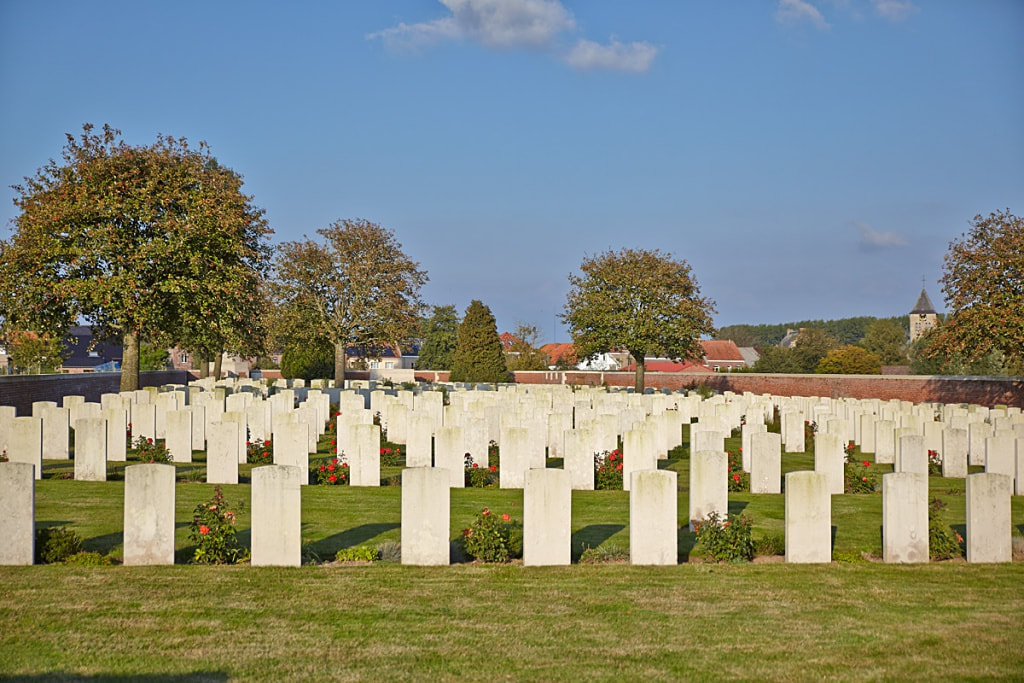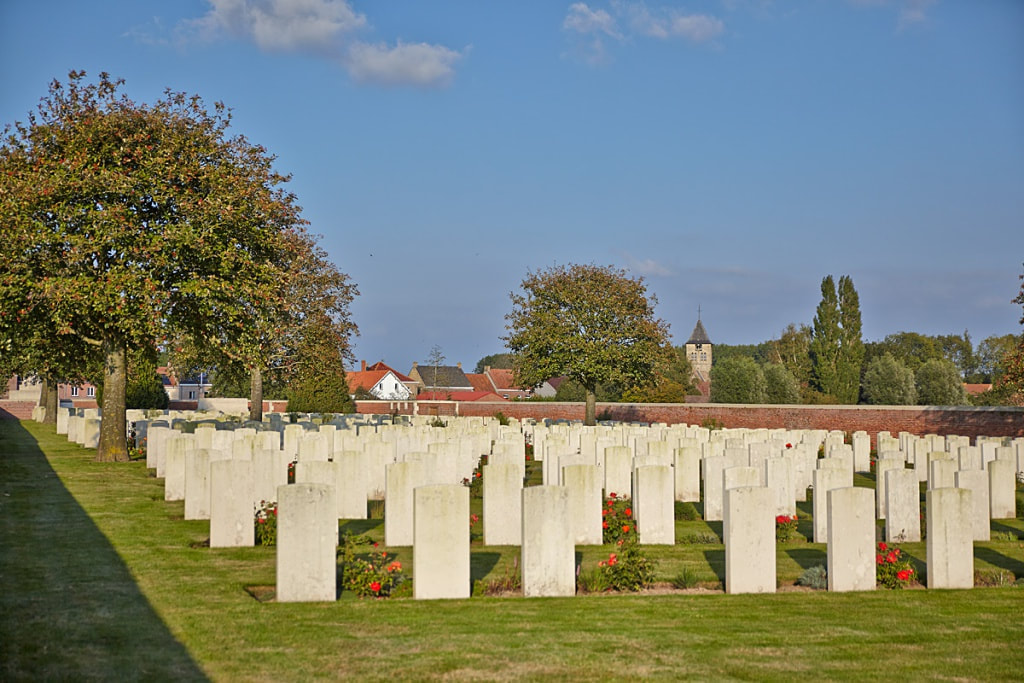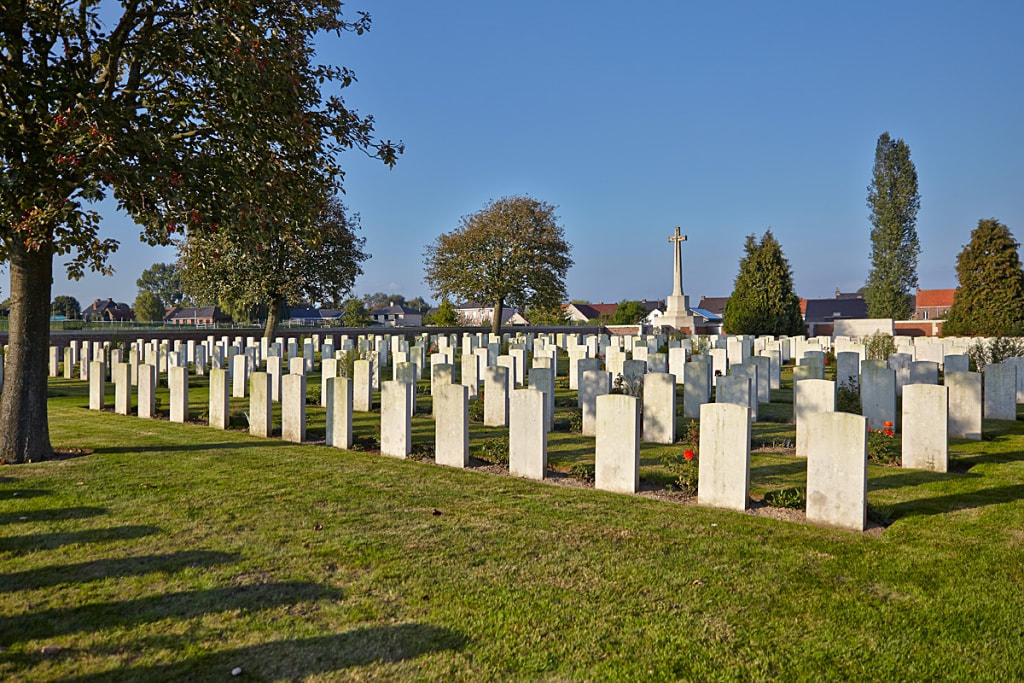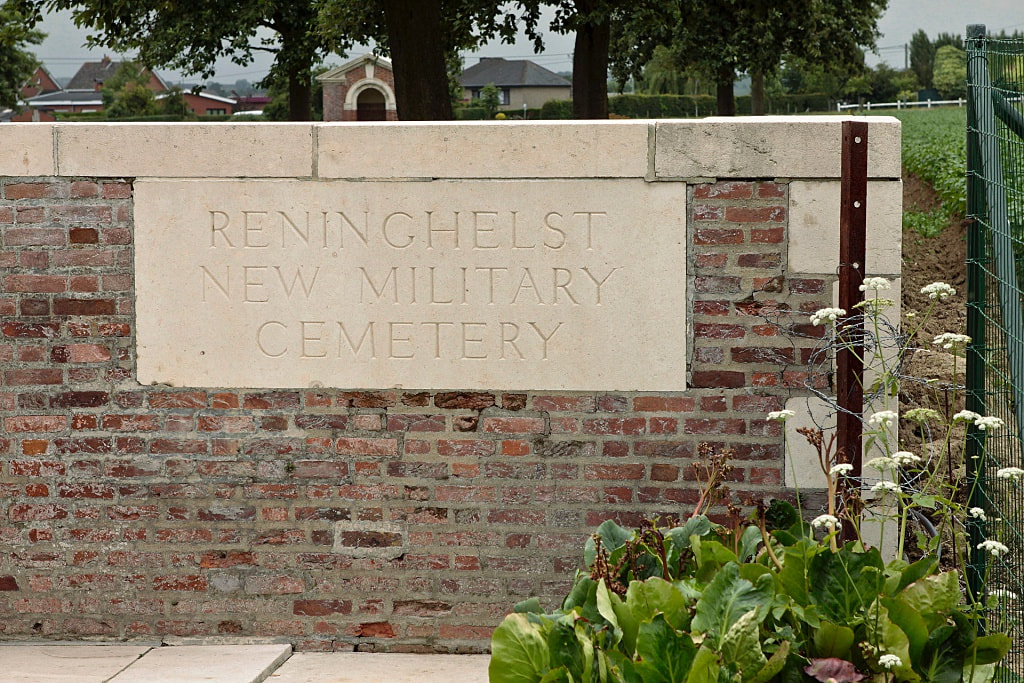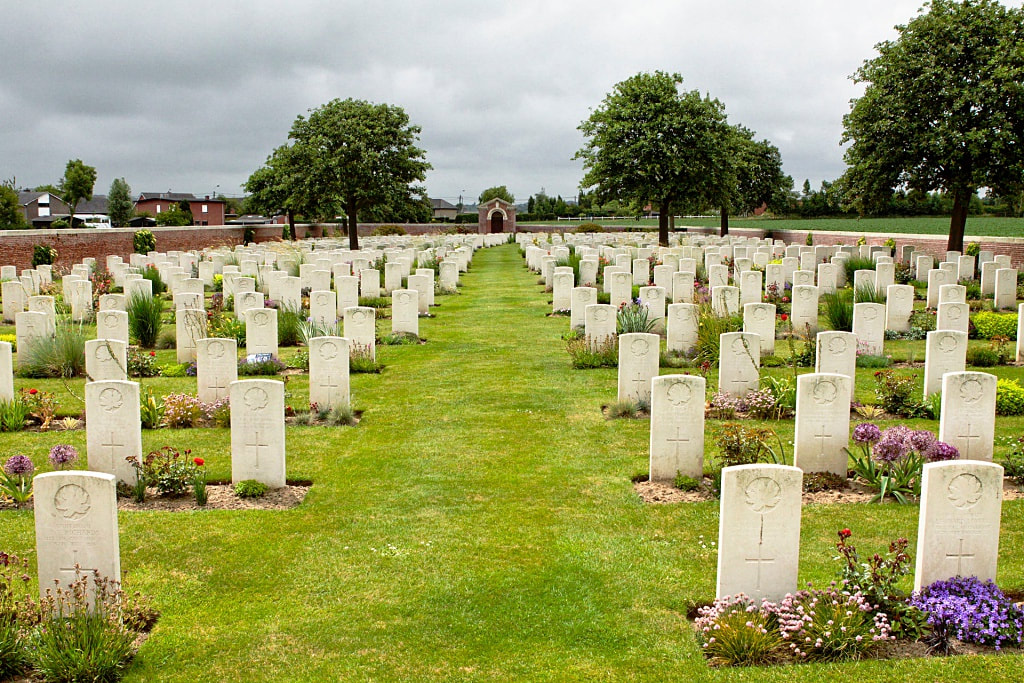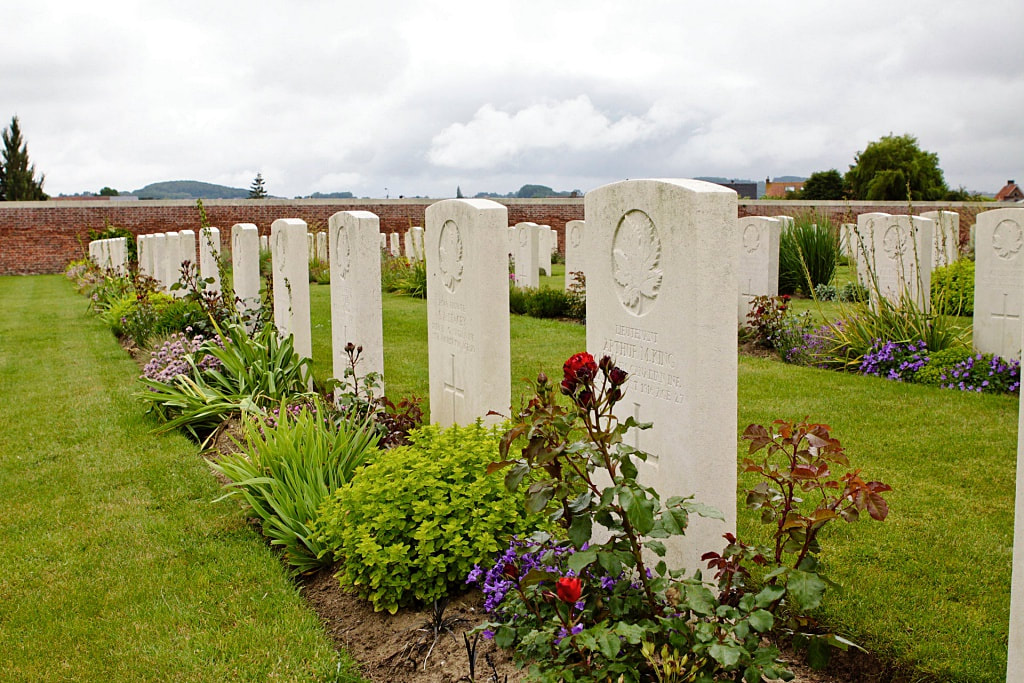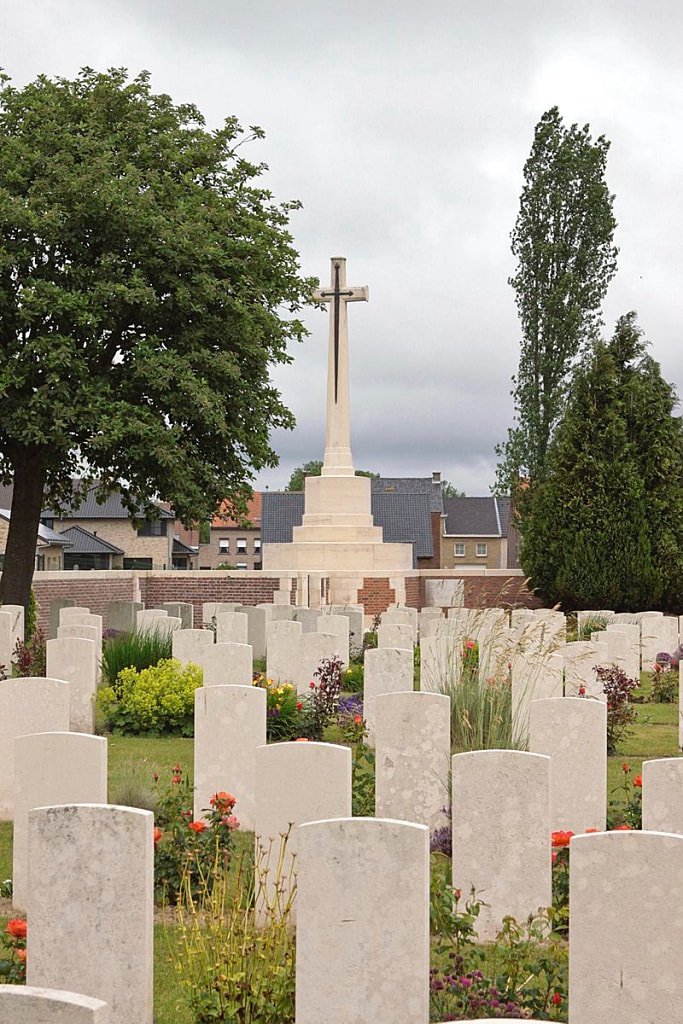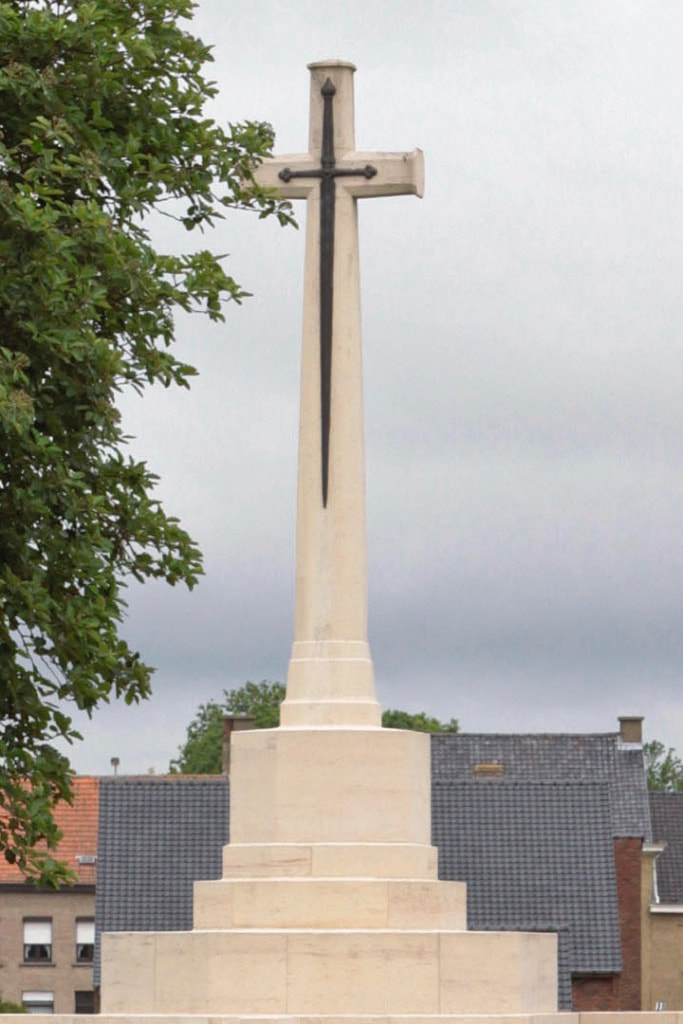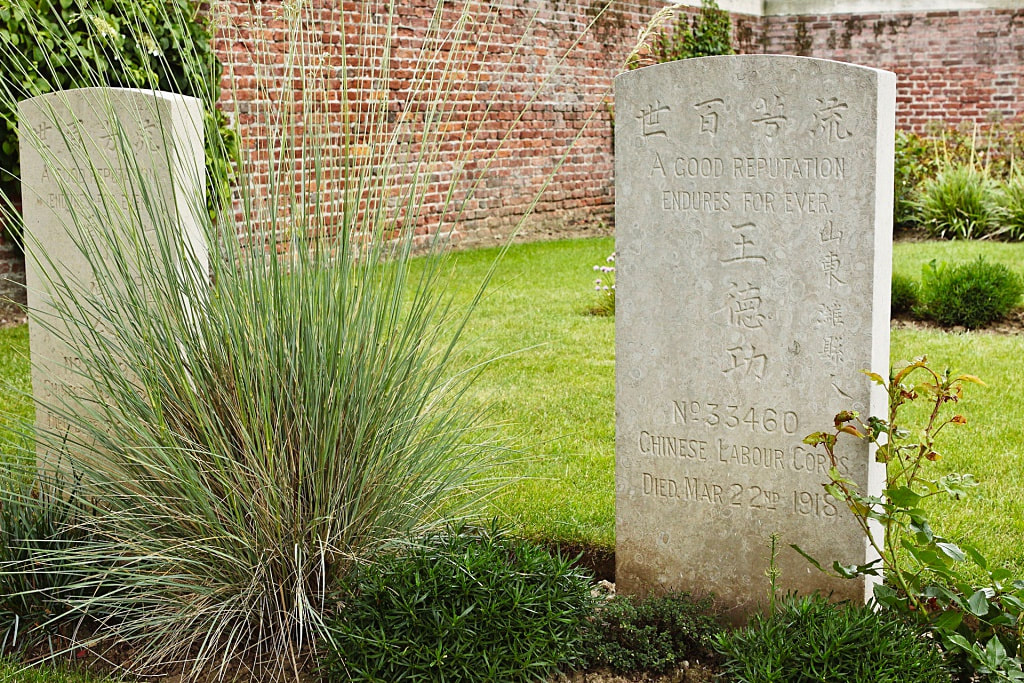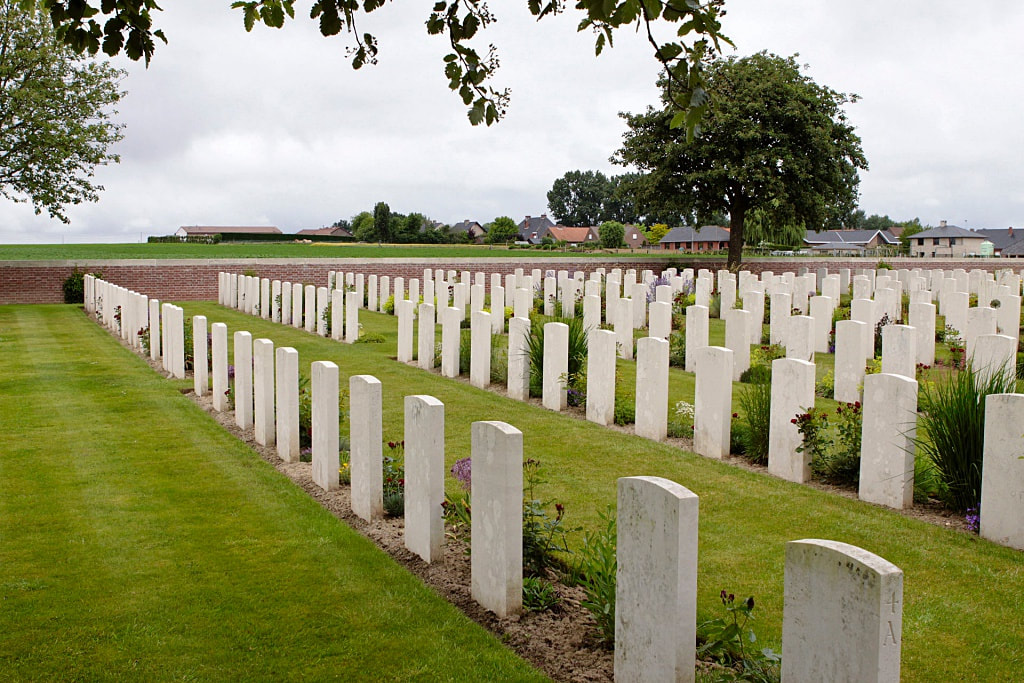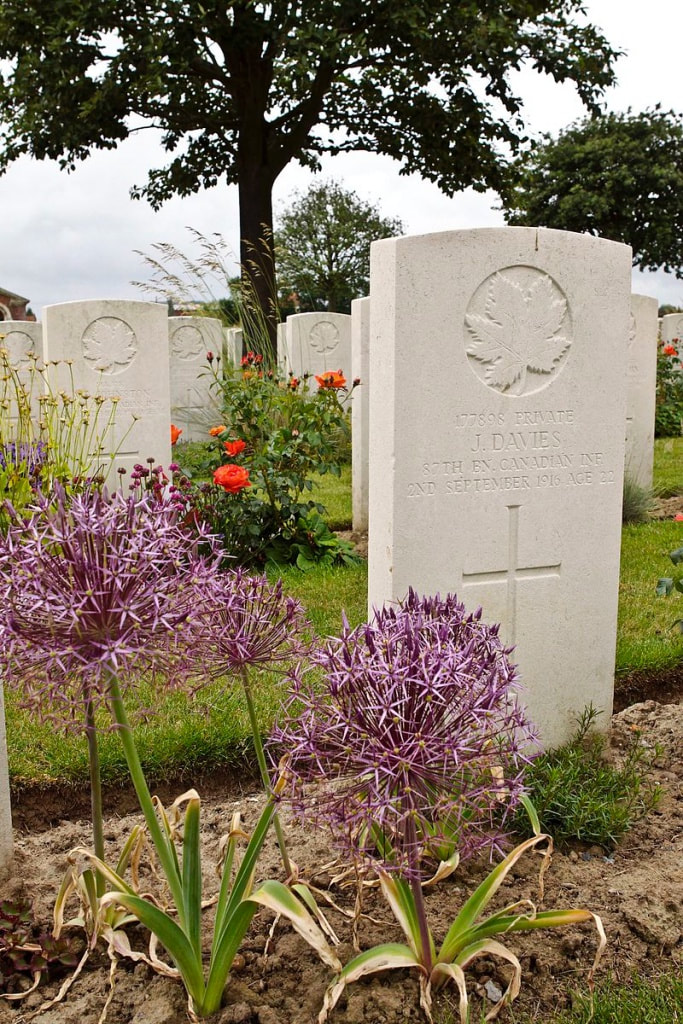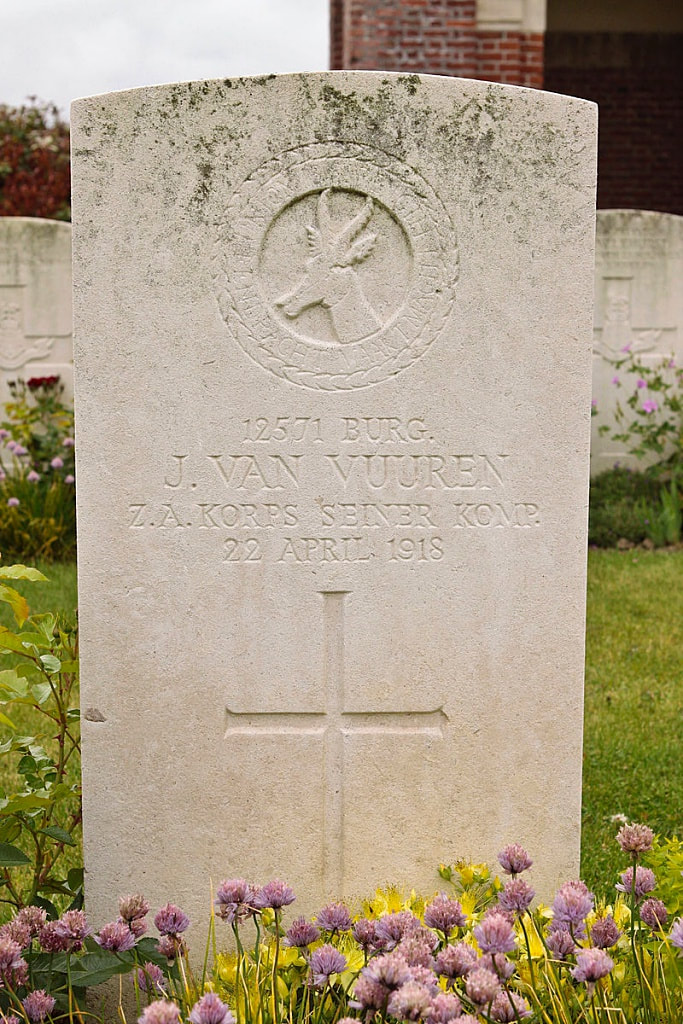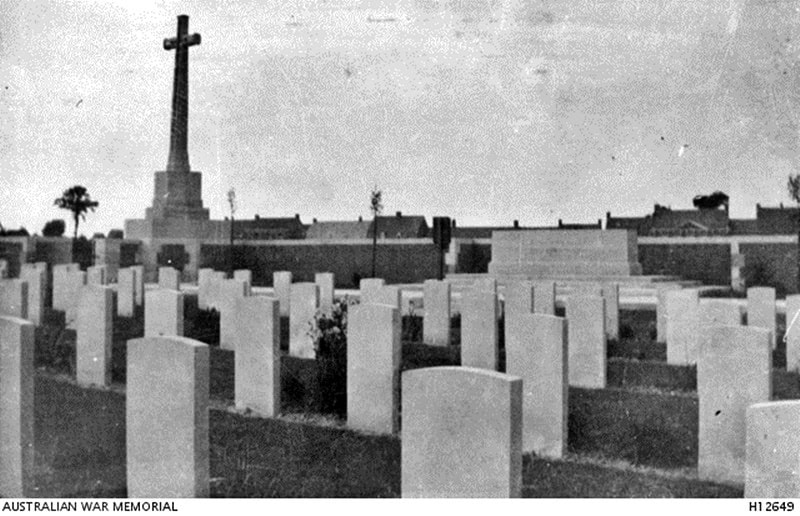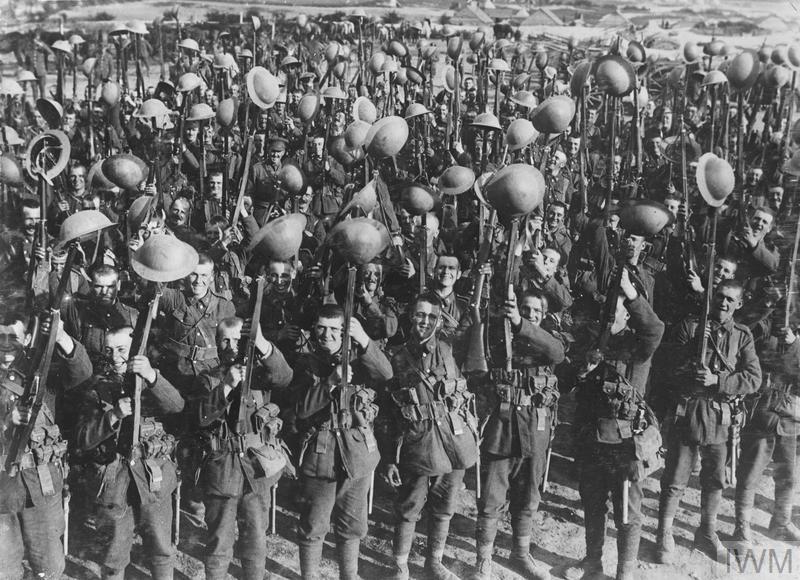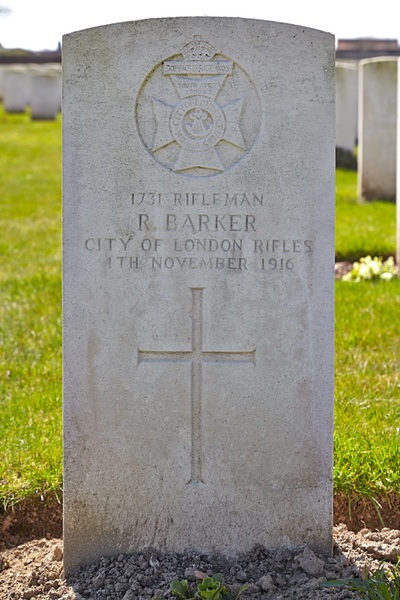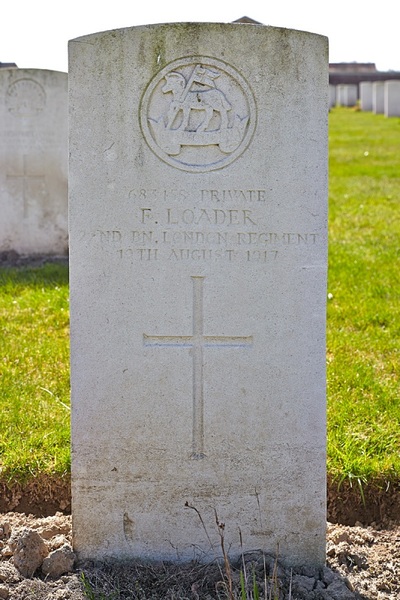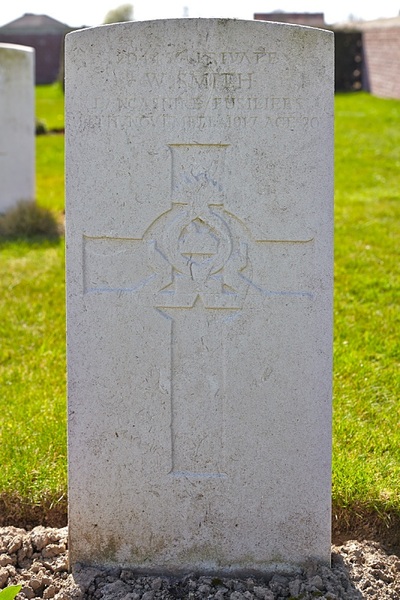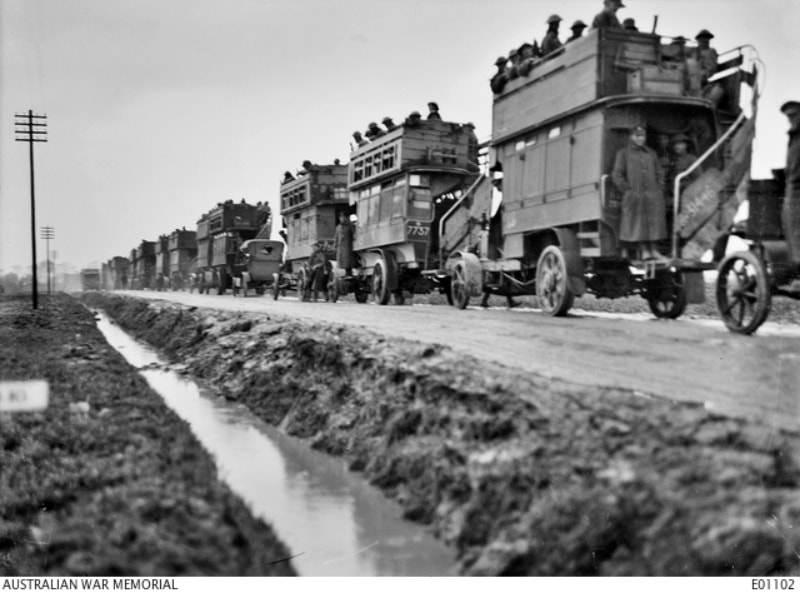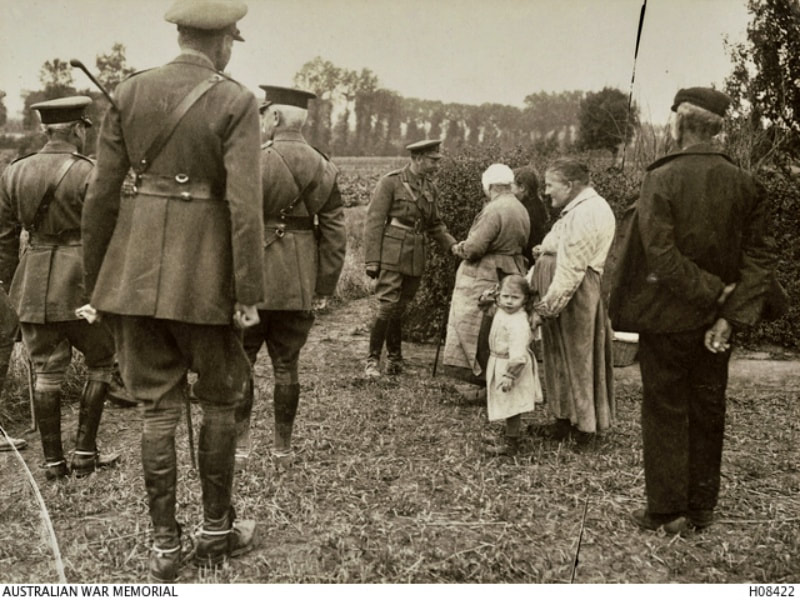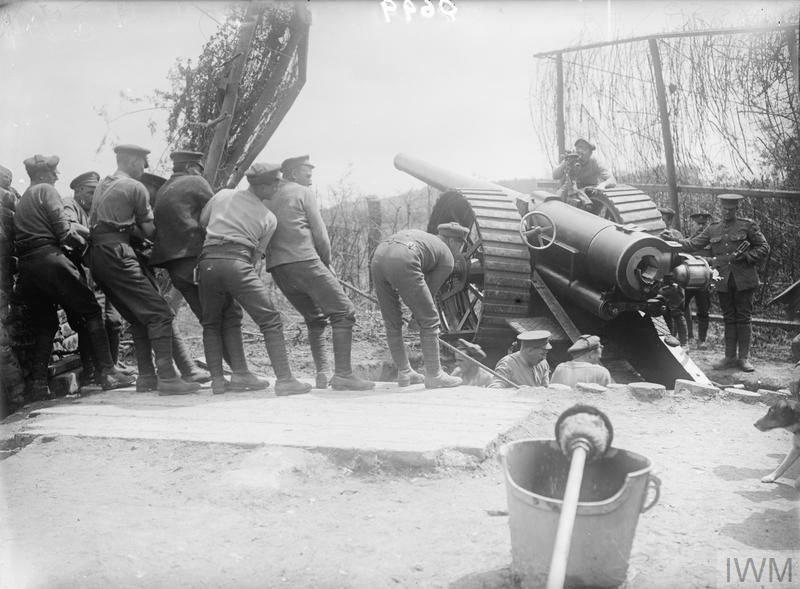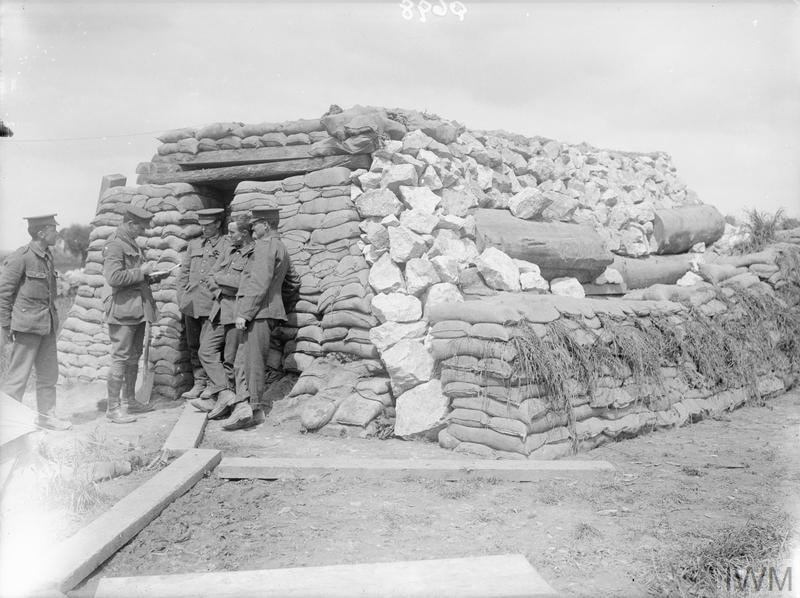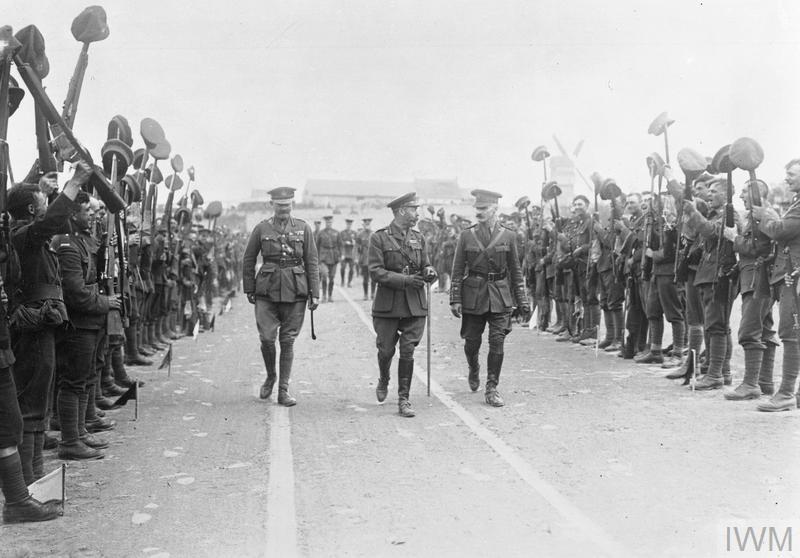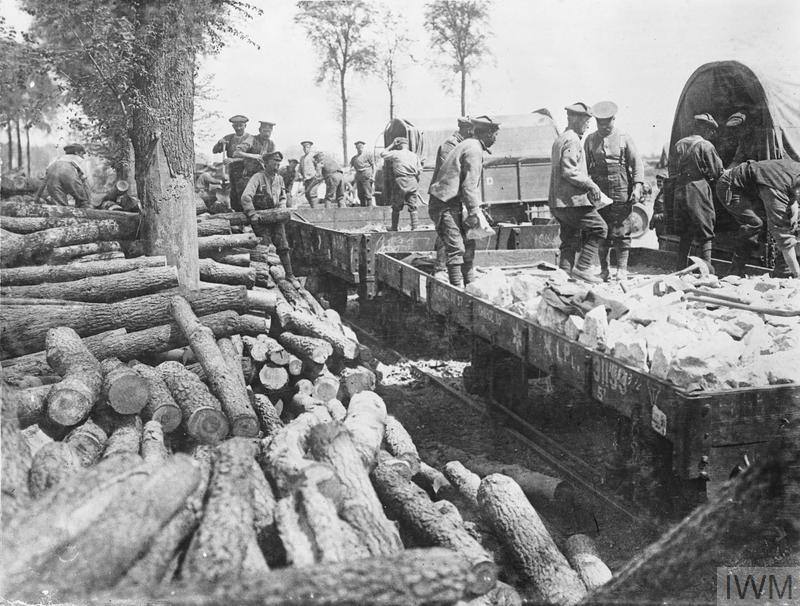RENINGHELST NEW MILITARY CEMETERY
West-Vlaanderen
Belgium
GPS Coordinates Latitude: 50.81703 Longitude: 2.75991
Location Information
Reninghelst New Military Cemetery is located 9.5 Kms south west of Ieper (formerly Ypres) town centre, in the village of Reningelst (formerly Reninghelst), on a road leading from the N308 Poperingseweg.
From Ieper town centre the Poperingseweg (N308), is reached via Elverdingsestraat then directly over two small roundabouts in the J. Capronstraat. The Poperingseweg is a continuation of the J. Capronstraat and begins after a prominent railway level crossing.
On reaching the main crossroads in the village of Vlamertinge take the left hand turning onto the Bellestraat. After crossing the N38 Ieper Poperinge road, the village of Reningelst lies 6 Kms beyond Vlamertinge. On reaching the village, turn right onto the Zevekotestraatand continue to the Reningelstplein where the churchyard is clearly visible. The Baljuwstraat leads from the Reningelstplein and the cemetery is 500 metres along this road on the left hand side.
Visiting Information
Visitors to this site should note a short grassed access path to this site, which is unsuitable for vehicles
The location or design of this site makes wheelchair access impossible.
Historical Information
The village of Reninghelst (now Reningelst) was occupied by Commonwealth forces from the late autumn of 1914 to the end of the war and was sufficiently far from the front line to provide a suitable station for field ambulances. The earliest burials took place in the Churchyard, but in November 1915, the New Military Cemetery was opened. It remained in use until September 1918.
There are now 798 Commonwealth burials of the First World War in the cemetery.
The cemetery was designed by Sir Reginald Blomfield and Noel Ackroyd Rew
Total Burials: 800.
Identified Casualties: United Kingdom 456, Canada 229, Australia 104, Germany 2, New Zealand 2, South Africa 1. Total 794.
Unidentified Casualties: 4.
Reninghelst New Military Cemetery is located 9.5 Kms south west of Ieper (formerly Ypres) town centre, in the village of Reningelst (formerly Reninghelst), on a road leading from the N308 Poperingseweg.
From Ieper town centre the Poperingseweg (N308), is reached via Elverdingsestraat then directly over two small roundabouts in the J. Capronstraat. The Poperingseweg is a continuation of the J. Capronstraat and begins after a prominent railway level crossing.
On reaching the main crossroads in the village of Vlamertinge take the left hand turning onto the Bellestraat. After crossing the N38 Ieper Poperinge road, the village of Reningelst lies 6 Kms beyond Vlamertinge. On reaching the village, turn right onto the Zevekotestraatand continue to the Reningelstplein where the churchyard is clearly visible. The Baljuwstraat leads from the Reningelstplein and the cemetery is 500 metres along this road on the left hand side.
Visiting Information
Visitors to this site should note a short grassed access path to this site, which is unsuitable for vehicles
The location or design of this site makes wheelchair access impossible.
Historical Information
The village of Reninghelst (now Reningelst) was occupied by Commonwealth forces from the late autumn of 1914 to the end of the war and was sufficiently far from the front line to provide a suitable station for field ambulances. The earliest burials took place in the Churchyard, but in November 1915, the New Military Cemetery was opened. It remained in use until September 1918.
There are now 798 Commonwealth burials of the First World War in the cemetery.
The cemetery was designed by Sir Reginald Blomfield and Noel Ackroyd Rew
Total Burials: 800.
Identified Casualties: United Kingdom 456, Canada 229, Australia 104, Germany 2, New Zealand 2, South Africa 1. Total 794.
Unidentified Casualties: 4.
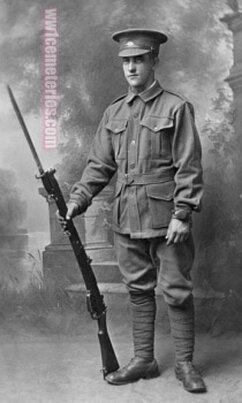
1673A Private
Robert John Batty
16th Bn. Australian Infantry, A. I. F.
11th October 1916, aged 20.
Plot II. B. 14.
A gardener of Norwood, SA, prior to enlistment, he embarked on HMAT Borda on 11 January 1916. Pte Batty died of accidental injuries at Reninghelst, Belgium, on 11 October 1916; he was aged 20 years.
Robert John Batty
16th Bn. Australian Infantry, A. I. F.
11th October 1916, aged 20.
Plot II. B. 14.
A gardener of Norwood, SA, prior to enlistment, he embarked on HMAT Borda on 11 January 1916. Pte Batty died of accidental injuries at Reninghelst, Belgium, on 11 October 1916; he was aged 20 years.
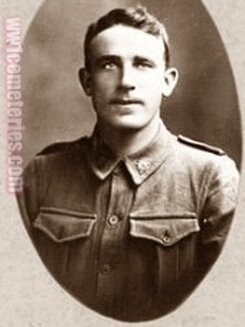
1750 Corporal
John Victor Bias
3rd Bty. 1st Bde. Australian Field Artillery
21st July 1917, aged 30.
Plot III. D. 6.
Son of Thomas Hunter Bias and Jane Spence Bias, of Flaws, Birsay, Orkney, Scotland.
John Victor Bias
3rd Bty. 1st Bde. Australian Field Artillery
21st July 1917, aged 30.
Plot III. D. 6.
Son of Thomas Hunter Bias and Jane Spence Bias, of Flaws, Birsay, Orkney, Scotland.
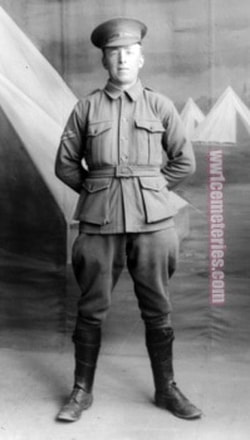
10387 Sergeant
William Thomas Burton
11th Bty. 4th Bde. Australian Field Artillery
6th September 1917, aged 26.
Plot IV. G. 20.
Son of William Thomas and Louisa Elizabeth Burton, of 17, Buckingham St., Richmond, Victoria, Australia.
From Richmond, Vic. Prior to his enlistment on 22 July 1915 in the AIF, he served with the 64th Infantry, Citizens Military Forces. Cpl Burton embarked from Melbourne aboard HMAT Afric on 5 January 1916. On 8 March 1916 he was transferred to the 4FAB and promoted to sergeant. Five days before his death, on 6 September 1917 in Zillebeke, Belgium, he received multiple shrapnel wounds to the back.
Bombardier W. J. Errington described the circumstances of William Burton's death:
"Burton's battery was in action to the right of Armour Wood, left of Hill 60. He and Cahill had just come off their gun and were late for dinner, which they were eating outside the Cook House. A percussion shrapnel shell struck the corner of the dugout, killing Cahill instantaneously and wounding Sergeant Burton in the back. He had 35 (shrapnel) pieces in his back. He was taken to a dressing station at Dickebusch, where he died."
William Thomas Burton
11th Bty. 4th Bde. Australian Field Artillery
6th September 1917, aged 26.
Plot IV. G. 20.
Son of William Thomas and Louisa Elizabeth Burton, of 17, Buckingham St., Richmond, Victoria, Australia.
From Richmond, Vic. Prior to his enlistment on 22 July 1915 in the AIF, he served with the 64th Infantry, Citizens Military Forces. Cpl Burton embarked from Melbourne aboard HMAT Afric on 5 January 1916. On 8 March 1916 he was transferred to the 4FAB and promoted to sergeant. Five days before his death, on 6 September 1917 in Zillebeke, Belgium, he received multiple shrapnel wounds to the back.
Bombardier W. J. Errington described the circumstances of William Burton's death:
"Burton's battery was in action to the right of Armour Wood, left of Hill 60. He and Cahill had just come off their gun and were late for dinner, which they were eating outside the Cook House. A percussion shrapnel shell struck the corner of the dugout, killing Cahill instantaneously and wounding Sergeant Burton in the back. He had 35 (shrapnel) pieces in his back. He was taken to a dressing station at Dickebusch, where he died."
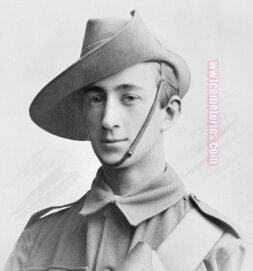
109 Corporal
Clive Gordon Clarke
1st Div. Signal Coy. Australian Engineers
8th November 1917, aged 23.
Plot IV. B. 17.
Son of Alfred Edward and Margaret Helen Clarke, of "Ashburnham," Cochrane St., North Rd., Brighton, Victoria, Australia. Born Melbourne, Victoria.
From Caulfield, Victoria. A 20 year old clerk prior to enlisting on 9 August 1914, he had been dux of All Saints Grammar School in St Kilda and was further educated at Stott and Hoare's Business College. He had been in the school cadets and was a signaller with the Citizens' Forces Engineers. He embarked for overseas as a driver from Melbourne on 20 October 1914 aboard HMAT Karroo but later reverted to sapper. He was in the first camp at Mene in Egypt and was in the first landing at Gallipoli as a signaller. After four months at Gallipoli, he was invalided out to Egypt where he later served as a despatch rider in the Sinai desert. He served in France for 18 months before being killed in action at Ypres, Belgium on 8 November 1917.
Clive Clarke was killed "coming past the church near the ramparts in Ypres" when a shell exploded underneath his motor cycle as he returned from ZonnebeKe after delivering a message.
Clive Gordon Clarke
1st Div. Signal Coy. Australian Engineers
8th November 1917, aged 23.
Plot IV. B. 17.
Son of Alfred Edward and Margaret Helen Clarke, of "Ashburnham," Cochrane St., North Rd., Brighton, Victoria, Australia. Born Melbourne, Victoria.
From Caulfield, Victoria. A 20 year old clerk prior to enlisting on 9 August 1914, he had been dux of All Saints Grammar School in St Kilda and was further educated at Stott and Hoare's Business College. He had been in the school cadets and was a signaller with the Citizens' Forces Engineers. He embarked for overseas as a driver from Melbourne on 20 October 1914 aboard HMAT Karroo but later reverted to sapper. He was in the first camp at Mene in Egypt and was in the first landing at Gallipoli as a signaller. After four months at Gallipoli, he was invalided out to Egypt where he later served as a despatch rider in the Sinai desert. He served in France for 18 months before being killed in action at Ypres, Belgium on 8 November 1917.
Clive Clarke was killed "coming past the church near the ramparts in Ypres" when a shell exploded underneath his motor cycle as he returned from ZonnebeKe after delivering a message.
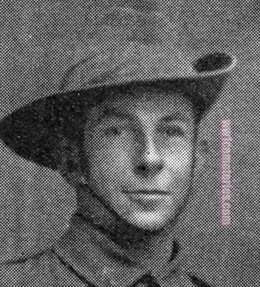
2967 Private
Alec Coe, M. M.
5th Field Amb. Australian Army Medical Corps
25th September 1917, aged 31.
Plot IV. D. 17.
Son of Sarah Ann Adams (formerly Coe). Born Bulga, Singleton, New South Wales.
A carriage painter prior to enlisting, he embarked from Sydney aboard HMAT Ajana on 31 May 1915. On 6 April 1917 Pte. Coe was awarded the Military Medal for bravery in the field on 24 March 1917 when along with three others, he braved heavy enemy fire to rescue two men who were wounded and lying near the road near Baupame, France and carry them 800 yards to safety. He was wounded in action during the battle at Menin Road, Belgium on 25 September 1917 and died later that day at the 3rd Canadian Casualty Clearing Station, Belgium, aged 31.
Alec Coe, M. M.
5th Field Amb. Australian Army Medical Corps
25th September 1917, aged 31.
Plot IV. D. 17.
Son of Sarah Ann Adams (formerly Coe). Born Bulga, Singleton, New South Wales.
A carriage painter prior to enlisting, he embarked from Sydney aboard HMAT Ajana on 31 May 1915. On 6 April 1917 Pte. Coe was awarded the Military Medal for bravery in the field on 24 March 1917 when along with three others, he braved heavy enemy fire to rescue two men who were wounded and lying near the road near Baupame, France and carry them 800 yards to safety. He was wounded in action during the battle at Menin Road, Belgium on 25 September 1917 and died later that day at the 3rd Canadian Casualty Clearing Station, Belgium, aged 31.
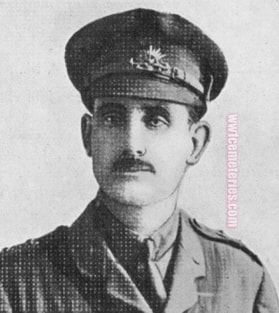
Captain
Walter Henry East, M C and 2 Bars, Mentioned in Despatches
1st Bde. Australian Field Artillery
5th October 1917, aged 30.
Plot IV. C. 5.
Son of William Henry and Mary Anne East, of Ramsay St., Rochester, Victoria, Australia.
A YMCA Assistant Secretary prior to enlisting, he embarked from Brisbane aboard HMAT Rangatira (A22) on 25 September 1914, with the 3rd Field Artillery Brigade, as 1645 Gunner East. He was involved in the Gallipoli campaign, promoted to Lieutenant and mentioned in despatches. He was awarded the Military Cross on 4 June 1917, for "consistent good work and devotion to duty during the period 26 October 1916 until 15 January 1917". A Bar to the Military Cross was awarded on 18 October 1917 "for conspicuous gallantry and devotion to duty". On 5 October 1917, during fighting at Westhoek Ridge, Belgium, he was killed in action, aged 30.
Walter Henry East, M C and 2 Bars, Mentioned in Despatches
1st Bde. Australian Field Artillery
5th October 1917, aged 30.
Plot IV. C. 5.
Son of William Henry and Mary Anne East, of Ramsay St., Rochester, Victoria, Australia.
A YMCA Assistant Secretary prior to enlisting, he embarked from Brisbane aboard HMAT Rangatira (A22) on 25 September 1914, with the 3rd Field Artillery Brigade, as 1645 Gunner East. He was involved in the Gallipoli campaign, promoted to Lieutenant and mentioned in despatches. He was awarded the Military Cross on 4 June 1917, for "consistent good work and devotion to duty during the period 26 October 1916 until 15 January 1917". A Bar to the Military Cross was awarded on 18 October 1917 "for conspicuous gallantry and devotion to duty". On 5 October 1917, during fighting at Westhoek Ridge, Belgium, he was killed in action, aged 30.
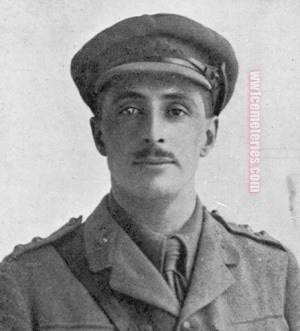
Captain
Alfred John Glendinning
2nd Bde. Australian Field Artillery
2nd August 1917, aged 22.
Plot III. C. 8.
Son of William and Eliza Glendinning, of 216, Hope St., Brunswick, Victoria, Australia.
A student teacher prior to enlisting, he embarked from Melbourne aboard HMAT Geelong (A2) on 17 September 1914. On 2 August 1917, aged 22, he was killed in action at Hooge farm, near Zillebeke lake, Belgium when an artillery shell struck a dugout on the Railway embankment.
Alfred John Glendinning
2nd Bde. Australian Field Artillery
2nd August 1917, aged 22.
Plot III. C. 8.
Son of William and Eliza Glendinning, of 216, Hope St., Brunswick, Victoria, Australia.
A student teacher prior to enlisting, he embarked from Melbourne aboard HMAT Geelong (A2) on 17 September 1914. On 2 August 1917, aged 22, he was killed in action at Hooge farm, near Zillebeke lake, Belgium when an artillery shell struck a dugout on the Railway embankment.
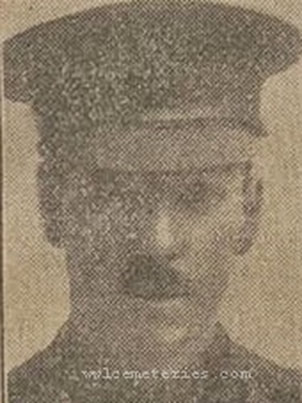
Captain
Gerard Montague Gordon
Adjt. 12th Bn. Royal Fusiliers
9th June 1917, aged 26.
Plot II. C. 26.
Son of George and Mary Gordon, of Wincombe Park, Wilts, and The Barn House, Sherborne, Dorset.
Gerard Montague Gordon
Adjt. 12th Bn. Royal Fusiliers
9th June 1917, aged 26.
Plot II. C. 26.
Son of George and Mary Gordon, of Wincombe Park, Wilts, and The Barn House, Sherborne, Dorset.
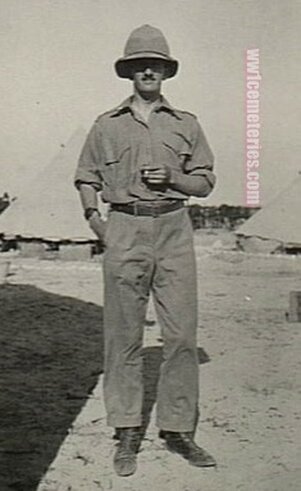
Major
Horace Frederick Kingsmill, D. S. O.
1st Bde. Australian Field Artillery
8th August 1917
Plot III. C. 21.
Son of John Johnson Kingsmill and Amy Elizabeth Kingsmill, of "Mitra," Olive St., Albury, New South Wales. Born Gunnedah, New South Wales.
Horace Frederick Kingsmill, D. S. O.
1st Bde. Australian Field Artillery
8th August 1917
Plot III. C. 21.
Son of John Johnson Kingsmill and Amy Elizabeth Kingsmill, of "Mitra," Olive St., Albury, New South Wales. Born Gunnedah, New South Wales.
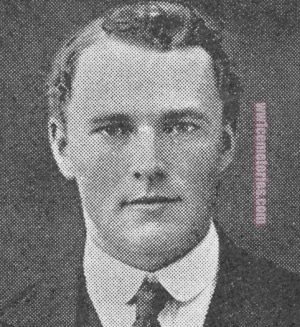
479 Sergeant
Edward Walpole Lewin, D. C. M.
2nd Bde. Australian Field Artillery
22nd August 1917, aged 23.
Plot III. A. 11.
Son of J. T. and Eliza Lewin, of Fifth Avenue, Hyde Park, Lidcombe, New South Wales. Born Parramatta, New South Wales.
A French polisher prior to enlisting, he embarked from Sydney aboard HMAT Pera (A4) on 26 September 1914. He was killed in action, on 22 August 1917, during the Third Battle of Ypres, Belgium, aged 23.
Edward Walpole Lewin, D. C. M.
2nd Bde. Australian Field Artillery
22nd August 1917, aged 23.
Plot III. A. 11.
Son of J. T. and Eliza Lewin, of Fifth Avenue, Hyde Park, Lidcombe, New South Wales. Born Parramatta, New South Wales.
A French polisher prior to enlisting, he embarked from Sydney aboard HMAT Pera (A4) on 26 September 1914. He was killed in action, on 22 August 1917, during the Third Battle of Ypres, Belgium, aged 23.
Images in this gallery © Geerhard Joos
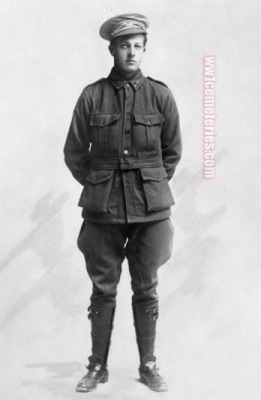
2519 Driver
William John Mountain
1st Bde. Australian Field Artillery
24th August 1917, aged 25.
Plot III. A. 18.
Son of William John and Julia Mountain, of Buckley St., Essendon, Victoria, Australia.
A draughtsman of Essendon, Victoria, he embarked on HMAT Orsova with the 4th Reinforcements. He later transferred to the 1st Divisional Ammunition Column then the 1st Field Artillery Brigade. He was killed in action at Reninghelst near Ypres, Belgium, on 24 August 1917, aged 25; he was the only son of William John Mountain senior, the Mayor of Essendon.
Killed by a direct hit from a 5.9 shell on his gun pit whilst in action at Zillebeke.
William John Mountain
1st Bde. Australian Field Artillery
24th August 1917, aged 25.
Plot III. A. 18.
Son of William John and Julia Mountain, of Buckley St., Essendon, Victoria, Australia.
A draughtsman of Essendon, Victoria, he embarked on HMAT Orsova with the 4th Reinforcements. He later transferred to the 1st Divisional Ammunition Column then the 1st Field Artillery Brigade. He was killed in action at Reninghelst near Ypres, Belgium, on 24 August 1917, aged 25; he was the only son of William John Mountain senior, the Mayor of Essendon.
Killed by a direct hit from a 5.9 shell on his gun pit whilst in action at Zillebeke.
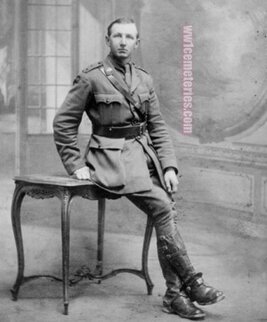
Lieutenant
Harry Nagel
11th Bde. Australian Field Artillery
17th October 1917, aged 30.
Plot IV. C. 13.
Son of John Henry Louis Nagel and Emily Nagel; husband of Ethel Nagel, of Kununoppin, Western Australia. Born Victoria, Australia.
A business manager before enlisting on 17 August 1914. He embarked from Fremantle on 31 October 1914, on HMAT Medic, as Quartermaster Sergeant with the 8th Battery of the 3rd Field Artillery brigade, regimental number 1861. After serving on Gallipoli, he was transferred to 112th Battery, 24th Howitzer Brigade.
He was promoted to Lieutenant on 1 August 1916, and transferred to 111th Battery, 11th Field Artillery Brigade on 25 January 1917. On 22 July 1917 he was wounded in Belgium and evacuated to hospital in Le Havre; on 3 August 1917 he rejoined his unit in Belgium. On 17 October 1917 he was killed in action in Belgium: while returning along the duckboard walk from Zonnebeke to the battery position near Kit and Kat Ridge, he was hit by a shell. He was mentioned in despatches dated 7 November 1917.
Harry Nagel
11th Bde. Australian Field Artillery
17th October 1917, aged 30.
Plot IV. C. 13.
Son of John Henry Louis Nagel and Emily Nagel; husband of Ethel Nagel, of Kununoppin, Western Australia. Born Victoria, Australia.
A business manager before enlisting on 17 August 1914. He embarked from Fremantle on 31 October 1914, on HMAT Medic, as Quartermaster Sergeant with the 8th Battery of the 3rd Field Artillery brigade, regimental number 1861. After serving on Gallipoli, he was transferred to 112th Battery, 24th Howitzer Brigade.
He was promoted to Lieutenant on 1 August 1916, and transferred to 111th Battery, 11th Field Artillery Brigade on 25 January 1917. On 22 July 1917 he was wounded in Belgium and evacuated to hospital in Le Havre; on 3 August 1917 he rejoined his unit in Belgium. On 17 October 1917 he was killed in action in Belgium: while returning along the duckboard walk from Zonnebeke to the battery position near Kit and Kat Ridge, he was hit by a shell. He was mentioned in despatches dated 7 November 1917.
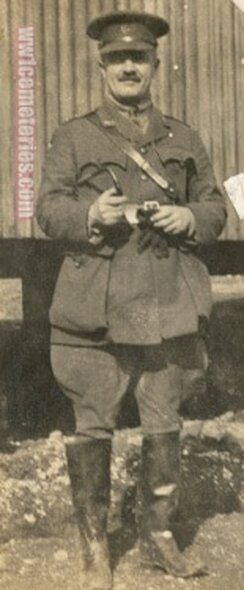
Lieutenant
Audley Parker
1st Bde. Australian Field Artillery
21st July 1917, aged 37.
Plot III. D. 4.
Son of William Henry and Kathleen Juliet Parker, of Chasely St., Auchenflower, Brisbane, Queensland.
A bank clerk from Milton Queensland, prior to enlistment, he embarked as 2382 Gunner (Gnr) Parker with the 6th Battery, 3 FAB, from Brisbane on 25 September 1914 aboard HMAT Rangatira (A22) for Egypt. The brigade landed at Gallipoli and remained until withdrawal back to Egypt in late December 1915. In late March 1916 3 FAB relocated to the Western Front, France. In mid May 1916 Gnr Parker was promoted to Second Lieutenant (2nd Lt) and transferred to 21 FAB which was then located at Fleurbaix. 2nd Lt Parker was promoted to Lieutenant in September 1916 and was then transferred to 1 FAB in late February 1917. Lt Parker was wounded in action near Ypres on 21 July 1917, died later that day at the 55th Field Ambulance.
Audley Parker
1st Bde. Australian Field Artillery
21st July 1917, aged 37.
Plot III. D. 4.
Son of William Henry and Kathleen Juliet Parker, of Chasely St., Auchenflower, Brisbane, Queensland.
A bank clerk from Milton Queensland, prior to enlistment, he embarked as 2382 Gunner (Gnr) Parker with the 6th Battery, 3 FAB, from Brisbane on 25 September 1914 aboard HMAT Rangatira (A22) for Egypt. The brigade landed at Gallipoli and remained until withdrawal back to Egypt in late December 1915. In late March 1916 3 FAB relocated to the Western Front, France. In mid May 1916 Gnr Parker was promoted to Second Lieutenant (2nd Lt) and transferred to 21 FAB which was then located at Fleurbaix. 2nd Lt Parker was promoted to Lieutenant in September 1916 and was then transferred to 1 FAB in late February 1917. Lt Parker was wounded in action near Ypres on 21 July 1917, died later that day at the 55th Field Ambulance.
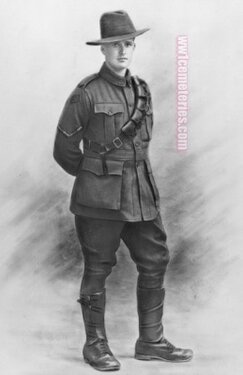
2253 Bombardier
Stanley Gordon Wise
2nd Bde. Australian Field Artillery
16th August 1917, aged 27.
Plot III. B. 13.
Son of John Maudling Wise and Mary McDonald Wise, of Tyers St., Portland, Victoria, Australia. Born Ballarat, Victoria.
From Ballarat, Vic. Bdr Wise enlisted as a driver with 3rd Field Artillery Brigade on 19 August 1914, and embarked from Melbourne on 19 September 1914 aboard HMAT Geelong. He was killed in action on 16 August 1917 aged 27.
Stanley Gordon Wise
2nd Bde. Australian Field Artillery
16th August 1917, aged 27.
Plot III. B. 13.
Son of John Maudling Wise and Mary McDonald Wise, of Tyers St., Portland, Victoria, Australia. Born Ballarat, Victoria.
From Ballarat, Vic. Bdr Wise enlisted as a driver with 3rd Field Artillery Brigade on 19 August 1914, and embarked from Melbourne on 19 September 1914 aboard HMAT Geelong. He was killed in action on 16 August 1917 aged 27.
Images in this gallery © Werner Van Caneghem
Shot at Dawn
1731 Rifleman, Robert Loveless Barker, 1st/6th Bn. London Regiment (City of London Rifles), executed for cowardice 4th November 1916, aged 21. Plot II. E. 15.
On 8 June 1916, he was tried for desertion & sentenced to death (which was later commuted to 5 years’ Penal Servitude, suspended).
By 15 Sept 1916 his battalion had taken heavy casualties in capturing German trenches in the area of Flers-Courcelette, & retained only a precarious hold over their gains in the next few days. On the morning of 18 Sept, Barker had refused to come out of his funk-hole & covered himself with sandbags, saying: ’I won’t come out for you or anyone else’. When the Germans counter-attacked the next day, Barker left the trench & ran to the rear, not being seen again by his battalion until 22 Sept, after they had been relieved, when he reported to the orderly room, handing in a certificate the terms of which implied that he had been detained in a Field Ambulance.
At trial, Barker said — as to Sept 18 — that he had left the funk-hole after the third order to do so. Regarding the events of the following day, he said that he had left the trench solely to warn the Lewis gunners in the trench behind him of the German attack (a warning confirmed in evidence by the gun team); that he had tried to go forward again, but the trench was blocked; that he later waited in a shell-hole for it to quieten down, only to find on returning to the trench that the battalion had been relieved; & that he had had his eyes bathed at the Field Ambulance.
After conviction, the Brigade commander wrote, inter alia, that Barker was a degenerate……whose ‘presence in the ranks was a danger’. The Corps commander considered that no example was necessary, but the Army commander disagreed, as did the C-in-C. (Corns, pp. 205-206, 212)
683458 Private Frederick Loader, 1st/22nd Bn. London Regiment, executed for desertion 19th August 1917, Plot III. B. 14.
He was already subject to a suspended sentence of death for desertion when he went absent on the first day of the Messines offensive. (Putkowski, pp. 186-187)
204455 Private William Smith, 3rd/5th Bn. Lancashire Fusiliers, executed for desertion 14th November 1917, aged 20. Plot IV. B. 28. Son of Robert and Ada Smith, of 16, Lord St., Pendleton, Manchester.
He had previously served at Gallipoli; & was convicted of desertion & cowardice when his battalion had been serving for some months in the autumn offensive in the Ypres Salient. (Putkowski, p. 189)
Pictures of gravestones below © Geerhard Joos
1731 Rifleman, Robert Loveless Barker, 1st/6th Bn. London Regiment (City of London Rifles), executed for cowardice 4th November 1916, aged 21. Plot II. E. 15.
On 8 June 1916, he was tried for desertion & sentenced to death (which was later commuted to 5 years’ Penal Servitude, suspended).
By 15 Sept 1916 his battalion had taken heavy casualties in capturing German trenches in the area of Flers-Courcelette, & retained only a precarious hold over their gains in the next few days. On the morning of 18 Sept, Barker had refused to come out of his funk-hole & covered himself with sandbags, saying: ’I won’t come out for you or anyone else’. When the Germans counter-attacked the next day, Barker left the trench & ran to the rear, not being seen again by his battalion until 22 Sept, after they had been relieved, when he reported to the orderly room, handing in a certificate the terms of which implied that he had been detained in a Field Ambulance.
At trial, Barker said — as to Sept 18 — that he had left the funk-hole after the third order to do so. Regarding the events of the following day, he said that he had left the trench solely to warn the Lewis gunners in the trench behind him of the German attack (a warning confirmed in evidence by the gun team); that he had tried to go forward again, but the trench was blocked; that he later waited in a shell-hole for it to quieten down, only to find on returning to the trench that the battalion had been relieved; & that he had had his eyes bathed at the Field Ambulance.
After conviction, the Brigade commander wrote, inter alia, that Barker was a degenerate……whose ‘presence in the ranks was a danger’. The Corps commander considered that no example was necessary, but the Army commander disagreed, as did the C-in-C. (Corns, pp. 205-206, 212)
683458 Private Frederick Loader, 1st/22nd Bn. London Regiment, executed for desertion 19th August 1917, Plot III. B. 14.
He was already subject to a suspended sentence of death for desertion when he went absent on the first day of the Messines offensive. (Putkowski, pp. 186-187)
204455 Private William Smith, 3rd/5th Bn. Lancashire Fusiliers, executed for desertion 14th November 1917, aged 20. Plot IV. B. 28. Son of Robert and Ada Smith, of 16, Lord St., Pendleton, Manchester.
He had previously served at Gallipoli; & was convicted of desertion & cowardice when his battalion had been serving for some months in the autumn offensive in the Ypres Salient. (Putkowski, p. 189)
Pictures of gravestones below © Geerhard Joos
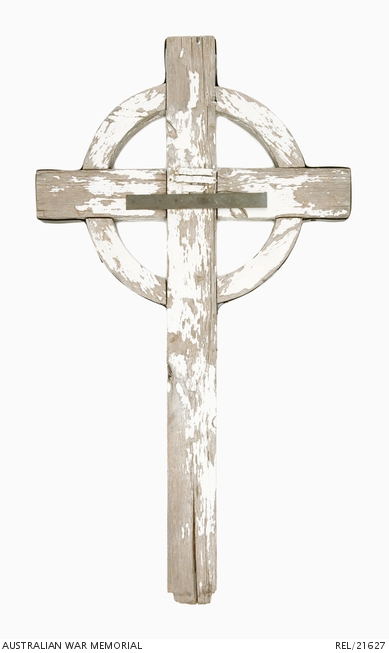
Wooden grave cross originally erected over the grave of Captain Geoffrey Erskine Wells, 11th Brigade AFA, AIF at Reninghelst Cemetery near Ypres in Belgium. Made and erected by his fellow officers, the cross is made of timber 9.5 x 5 cm in thickness. Its design is a cross with a circle through all four arms. The circle and the cross are held together by metal strips nailed to the wood. Cross arm is 61 cm long and the upright is 111cm long. Diameter across the circle is 44.5 cm. There are three small metal tags on the upright of the cross level with the cross arm, these are the grave's registry tags. There is another 27 cm metal strip across the arm below the registry tags. Cross was originally painted white. Captain Geoffrey Erskine Wells enlisted on 19 August 1914 and died of wounds received on Passchendaele Ridge on 6 October 1917. He served with 11 Field Artillery Brigade, AIF. He was a farmer from Walkerville, SA and was aged 26 when he died. He had been educated at St Peter's collegiate school and Roseworthy Agricultural College.The cross was returned to the family in Adelaide when permanent markers were erected in the cemeteries of the Western Front. This cross was erected next to the graves of Well's parents, Alfred and Gertrude Wells, at the North Road Cemetery, Nailsworth in Adelaide.
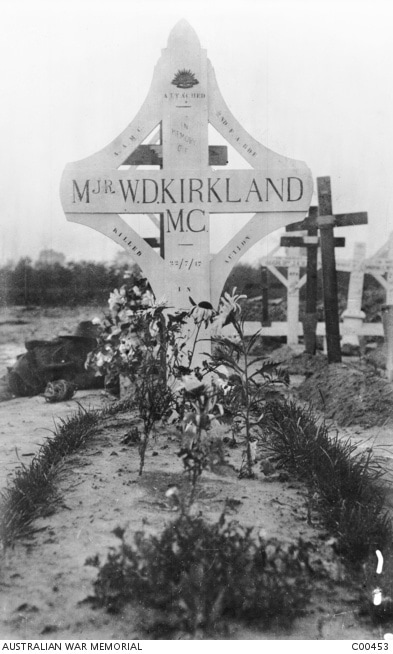
The grave of Major (Maj) William Duncan Kirkland MC of the Australian Army Medical Corps. Born in Bathurst, NSW, Maj Kirkland enlisted on 19 May 1916, joined the 2nd Australian Field Ambulance on 21 December and served as Medical Officer with the 2nd Field Artillery Brigade in the Somme and Ypres sectors from 1 February 1917. He was killed in action near Ypres on 22 July 1917 and is buried in the Reninghelst New Military Cemetery, Poperinge, West-Vlaanderen, Belgium. Maj Kirkland's brother Captain Hugh Edward Kirkland was also a doctor who served in France and was awarded the MC. He initially served at 2 Australian General Hospital, Wimereux, and then as Regimental Medical Officer (RMO), 54th Battalion from 30 April 1916 to 1 January 1917. He returned to Australia, then reembarked on 10 May 1917; he joined the 3rd Australian Field Ambulance on 16 August and was RMO, 2nd Artillery Brigade from 10 September at Ypres, Messines Ridge, Hazebrouck and the Somme. He was killed in action near Peronne on 3 October 1918, and is buried in Roisel Communal Cemetery Extension, Somme, France.

